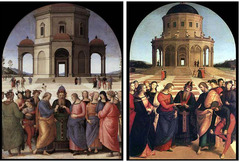
2: both have high level of asymmetry but the later one brought in more elements to add to the harmonious tension
3: both have the use of vanishing point to create perspective but the later one have a deeper dimension due to the changes in proportion
4: both have a correspondence between the left part and the right but in the left there are alternations of front and back but the right one only has a frontal view
5: light comes form different sides of the painting (may have something to do where the painting is placed in the church)
6: flipped composition and Maria’s face is lit in both images
7: both have atmospherical perspective misty backgrounds
8: the proximity between the figures create an engagement within the scene
9: In Raphael’s painting the Virgin’s right arm goes across the center of the scene to draw attention to the ring arm and hand: subject matter
10: In Raphael’s painting there is an extensive use of fundamental circle and as the result the harmony of the proportion is consciously achieved.
11: They both have a very important vertical axis but Raphael intentionally makes his axis go right between Joseph and Mary’s fingers. The Immediate tension thus is created.
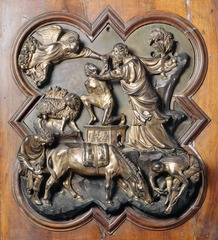
Competition Panel: Sacrifice of Issac (1401-1403)
2: The dramatic tension is immediate
3: The servants are separated from the center of the scene by a horizontal rocky bar
4: not so much scenery
5: quatrefoil
6: the servant at the left bottom of the scene is probably inspired by Spinario
7: consists of several separately cast parts
8: In his trail relief Brunelleschi organized the forms to focus on the dynamic figure of Abraham whose arm, lifted to strike Issac, is grasped by the angel rushing in from the left;
9: Issac, contorting his posture, struggling, increased the drama;
10: Great Naturalism and Great Drama

competition panel: Sacrifice of Issac(1401-1403)
2: it is less dramatic, milder and more elegant
3: The servants are separated by an integral rock that goes through the whole image and while separating also unifies the whole picture with an elegant land scape that is reminiscent of classical creation
4: more detailed and fluent modeling and casting. as one piece
5: quatrefoil
6: something important to notice: the artist is supposed to fill the four lobes of the quatrefoil while conveying the narrative succinctly and naturalistically.
7: Better in composition, rendering of the human form, and observation of natural details: technical Fineness
8: Ghiberti solved the problem of the quatrefoil field by placing narrative details in the margins and the focal point at the center;
9: great contrast between Issac’s nudity and his father’s drapery;
10: Ghiberti’s composition successively combines movement, focus, and narrative;
11: His interest in the Lyrical patterning of the the International Gothic Tempers the brutality of the scene.
12: Abraham’s drapery falls in cascades similar to those of the figure of Moses in Sluter’s The Well of Moses
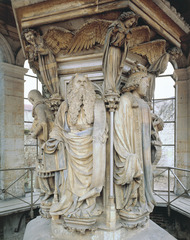
The Well of Moses
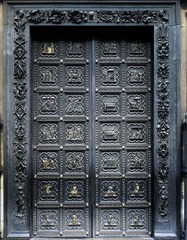
North Doors of the Florence Baptistry (1403-1424)
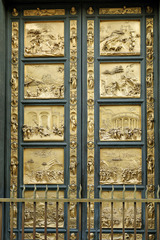
East Doors of the Florence Baptistry (1425-1452)
2: continuous narrative

Story of Jacob and Esau (1435)
2: detail: Issac touching the neck of Jacob which is covered in goat skin
3: Maids’ drapery has fluent curves and folds that is similar to that of Antiquity, eg. Hellenistic drapery
4: This also shows Ghiberti’s preference for elegant mild scenes
5: the use of Schiacciato
6: The graceful proportions, elegant stances, and fluid drapery of the figures bespeak Ghiberti’s allegiance to the International Gothic Style;
7: The hint of depth seen in The Sacrifice of Isaac has grown in here into a deeper space defined by the arches of a building planned to accommodate the figures as they appear and reappear throughout the structure in a continuous narrative
8: Ghiberti’s spacious hall is a fine example of Early Renaissance architectural design

South Doors of the Florence Baptistry (1330-1336)
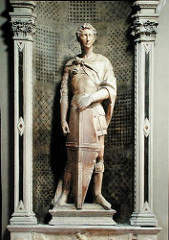
St. George (1410-1417)
Or
St Michele
Florence
2: half-turned pose:haughty look
3: maybe holding a bronze sword and wearing a bronze helmet
4: Donatello was one of the first people who pours psychological individuality and human mentality into the work
5: shallow niche makes the figure about to step out of it, thus even tho dressed in armor, he appears able to move his body easily
6: His stance, with the weight placed on the forward leg, suggests he is ready for combat;
7: The controlled energy is reflected in his eyes, which seem to scan the horizon for the enemy;
8: Portrayed as a Christian soldier;
9: Here on the relief Donatello devised a new form of shallow relief called Schiacciato, meaning flattened-out, yet he created an illusion of almost infinite depth.
10: In this relief, the landscape behind the figures consists of delicate surface modulations that catch light from varying angles;

Four Martyr Saints (1409-1406/7)
Or
St. Michele
Florence
2: fleshy and realistic body shown through the drapery
3: toga-statue revived
4: more freedom than the jamb figures on Chartres
5: contrapposto
6: Their bodies seem to spill out of the confines of the niche, draped as they are in the heavy folds of their togas
7: The drapery and the heads of the second and third of the Coronati directly recall Roman Portrait sculpture of the first century CE
8: It was as if Nanni was were situating the martyrs in their historical moment, and his figures emulate Roman verism and monumentality;
9: The relief below the saints represents a sculptor, stonecutters, and a mason at work, both explaining the story of the martyrs and advertising the skills of the patrons who commissioned the work. This double function occurs often in the statues designed for the niches on San Michele, reflecting the building’s double origin in commerce and piety.
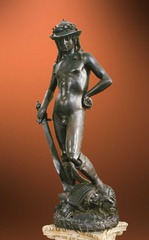
David, early 1420s-60s
*:sinuous s-curved contrapposto
*: slight smile with provocative charm
*: As Martin Kemp points out, David served as a civic role model-as a youth who rejected the armor offered to him and went to battle naked, and his victory is hence all the more remarkable for the contrast between the victor and his far more formidable foe. According to this view, David’s apparently classicizing nudity might also have narrative importance.
*: shows Donatello’s wide range of subject matter, imagination and artistic flexibility and high expertise in deploying technical media.
*David may have served as a symbol for the florentine pride and belief in their victory over the enemy, themselves as God’s chosen defender of fate: idealistic analogy
*: nudity is used here a reflection of a divine idea, since man is based on the image of God himself
*: and David’s identity as a Biblical figure justifies his nudity: not Pagan
*: a work of daring that shows Donatello’s pioneering in discovering imagery power conveyed in new forms and methods
*: the feather that goes all the way up his thigh adds to the erotism of the sculpture
*: the david may be the first free-standing , life size nude statue made since antiquity
*: The broad-brimmed hat and knee-high boots seem to accentuate his nudity

The Virgin and Child at the fountain
*: Yet van Eyck includes a rendering of a fountain of astonishing verisimilitude , the more so because of its tiny dimensions.
*: Designed maybe for private devotion
*:
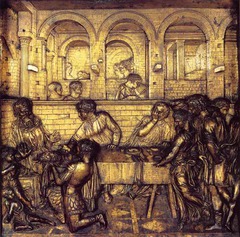
Feast of Herod
Baptistry of Siena, c, 1425
*: the roughness of the image conveys a sense of rapid motion and movement that is going to turn into a surprising violence
*: The gourmet of Salome indicates that was the end of her dance that is going to be followed by the execution and utter horror of the recoiling Herod,
*: The image consists of a complex architectural space that sets the background for a continuous narrative made of several stages of the development of the story
*: full of urgency and immediacy
*: again reflects Donatello’s mastery of a wide range of artistic styles
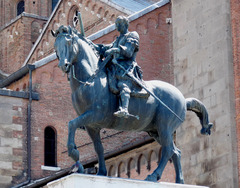
Gattamelata
Padua, 1445-1450
*: proud forwarding calvary culture different form the commanding solemnity of roman emperor Marcus Aurealius, which provides an uninterrupted heritage since antiquity
*: the use of repetitive curves and arches used brings a series of curvilinear lines echoing with each other
*haughty masculinity: holding the horse back and commanding: military figure
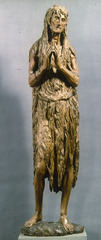
St. Mary Magdalen
1430-1450
*: the long thin sullen and withered texture of the media speaks for its subject matter
*: details such as missing teeth, hollow cheek, deep shadowed eyes all speak for the intensive religious nature of her and the harshness of life in the wild
*: this theme is a revolutionary select and use of subject


Madonna and child
Or San Michele, Florence
1465
* Brunelleschi Arch flanked by lilies
* The blue background highlights the flowers and the architectural forms
* eye contact between Mary& Child and the viewers
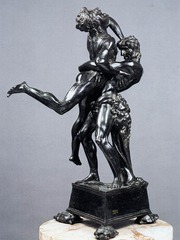
Hercules and Antaeus
c.1475
* the three-dimentianal form brings great and strong sense of motion
*: the use of pagan figures shows a new trend in Renaissance art that was not totally against the classical subject matter—- shifted and more relaxed attitude
*: Hercules was one of the patrons of Firenze
*: limbs seem to move outward in every direction, so the viewer must examine it from all the aspects
*:

Battle of the Ten Nude Men
c. 1465-1470
*: vibrant motion dynamics
* the use of sculptural depiction on the flat surface, ep, two sides of one man’s body was shown
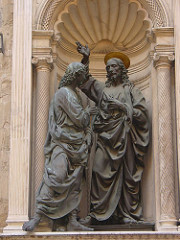
Doubting of Thomas
Or San Michele, Florence
1467-1483
* a symbol for justice: the gild
*: this sculpture shares with contemporary paintings an interest in textures, the play of light and dark in massive drapery folds, and illusionism
* the eloquent poses and bold exchange of gestures between Christ and Thomas convey the drama of the scene;
* the active drapery, with its deep folds, suggest the calm of Christ and the disturbance in Thomas’s mind
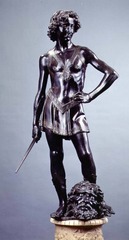
David
c.1475
*: less femininity
*: dressed

Equestrian Moment of Colleoni
Venice
c. 1483-1488
*: horse with forwarding position shows great movement and dynamic
*: graceful and spirited horse
*: thin hide reveals veins, muscles, and sinews, in contrast to the rigid surfaces of the armored figure bestriding it
*: forceful dominance
*:
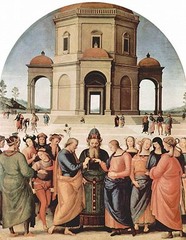
Marriage of the Virgin
1499-1504

Adoration of the Magi
1423
*Gothic: use of flat gold foils as halo
architectural frames
crowded composition
barely visible gold sky
continuous narrative
narrative stripes down the frame called Predella
stacked perspective
* Renaissance: the attempt of deploying perspectives: the groom boy and the horse
the subject matter comes from Florentine bankers’ seeking for salvation
* lavish triple-arched gilt frame of the altarpiece
* gable figures
* the combination of unified landscape and several episodes of the same story
* elegant figures, garbled in brocades, surrounded by colorful retainers
* gold leaf and tooled surface
* the pseudo-kufic inscriptions on the virgin and child’s halo attest to Gentile’s contact with Islamic works
* the three kings also represent the three ages of men
* A golden light unites the whole image, illuminating the bodies of the animals, the faces of the humans, and parts of the landscape
* the forms are softly modeled to suggest volume for the figures and to concentrate the strong flattening effect of the gold
* the predella shows gentile’s use of light to over the line and eliminate forms
* the mythical light carries symbolic meanings
* refined style
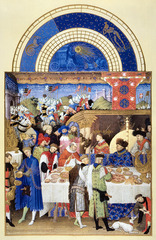
Tres Riches Heures du Duc de Berry
January&July pages
1413-1416
already showing space on a flat surface

The Expulsion from Paradise
Brancacci Chapel, Florence
1424-1427
* the nudity in a chapel brings a new momentum to biblical representation
*: fresco
* shows the human body in motion
* narrow format of this fresco leaves little room for a spatial setting
* the soft, atmospheric modeling, and especially the boldly foreshortened angel, convey a sense of unlimited space.
* the grieve-striken Adam and Eve are striking representations of the beauty and power of the nude human form
* in contrast to the fluid grace of Gentile’s painting, Masaccio;s paintings represent a less beautiful reality
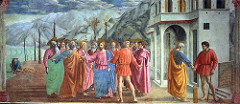
The Tribute Money
Brancacci Chapel, Florence
1424-1427
* fresco
* yellow&blue combo: symbol for St. Peter
* break-through: halos drawn in perspectives: instead of being represented as flat gold disks, they are visualized as actual objects
* the vanishing point being on Jesus’s face makes all the octagonal lines subliminal arrows that direct our attention to the central figure: symbolic resonance
* isocephalic arrangement: all the figures’ heads basically on the same level, and in here specially circularly arranged
* Masaccio uses perspective to create a deep space for the narrative and to link the painting’s space to the space of the viewers
* Masaccio models the forms in the picture with light that seems to have its source in the real window of the chapel
* He also uses atmospherical perspective in the subtle tones of the landscape to make the forms somewhat hazy
* shows his ability to merge the weight and volume of Giotto’s figures with the new functional view of body and drapery
* Fine vertical lines scratched in the plaster establish the axis of each figure from the head to the heel of the engaged leg. In accord with this dignified approach, the figures seem rather static.
* Instead of employing violent physical movement, Masaccio’s figures here convey the narrative by their intense glances and a few strong gestures.
*: relies on architectural elements to make up the pictorial space

St. Peter healing with his Shadow
Brancacci Chapel, Florence
1424-1427
* vanishing point arranged outside the picture as an adjustment to its position in the chapel
*: relies on architectural elements to make up the pictorial space
*: subtly and immediacy
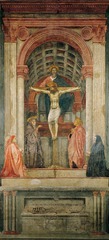
The Trinity
S, Maria Novella, Florence
1425
*: perfect one-point perspective
*: vanishing point arranged at the eye level to create both looking up and down: subject matter
* donors positioned in the painting both outside and lower
* the use of momentum memoir: sarcophagus
* the large scale, balanced composition, and sculptural volume of the figures have origins in the work of Giotto, but differently, Masaccio’s drapery falls in response to the body underneath
* The setting reveals the artist’s awareness of Brunelleschi’s new architecture and his system of perspectives
* the picture space is independent of the figures
* the figures inhabit the space but they do not create it
* the space seems measurable, palpable
* Masaccio further expresses the theme of the trinity by the triangular composition that begins with the donors and rises to the halo of God
* color balances the composition too, as opposing reds and blues unite in the garment worn by God
* The whole scene has a tragic air, made more solemn by the calm gesture of the Virgin, as she points to the Crucifixion, and by the understated grief of St. John the Evangelist
* The reality of death but promise of resurrection is an appropriate theme for a funerary commemoration
*: the first expression of the full potential of perspective
*: Masaccio uses the perspective construction to reinforce the conventions of the religious life
*: Instead of a hierarchy of scale, Masaccio introduces a hierarchy of hierarchy of levels. Echoed by how the architecture gets more and more richly ornamented when ascending
*: While all of the figures are modeled in space-the viewers look up at the figures so that the underside of Mary’s hand is more visible, we look up at John’s chin and up at he face of Christ-God evades the pictorial space and is presented fully frontal and parallel with the picture plane. This is no earthly being, unlike the other figures in the fresco, so he cannot inhabit the same space;
*: Only by having such a controlled space can God be depicted as transcending that space
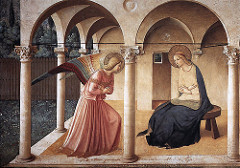
Annunciation
c. 1440-1445
partly due to the artist’s own religion
* gentle lines and colors
* old-fashioned: flat gold halos, grass spangled with flowers, mild emotions, distorted proportions
* new element: the use of perspectives in architectural depiction
*: Angelico sets the angel and Mary into a vaulted space very similar to the real architecture of the convent, itself inspired by Brunelleschi
*: A perspective scheme defines the space, although the figures are too large and stand comfortably in it
*: The Virgin and the angel Gabriel glance at each other across the space; they humbly fold their hands, expressing their submission to divine will;
* the forms are graceful, and the overall scene is spare, rather than extravagant
*: the colors are pale, the composition has been pared to the minimum, and the light baths all the forms in a soft glow
* Angelico’ composition has the simplicity and spatial sophistication of Masaccio, with figures that are as graceful as Gentile da Fabriano’s.
* The fresco enhanced their life of prayer and contemplation, as was the goal of such imagery in religious communities

Resurrection
Borgo S. Sepolcro
c. 1463
* dramatical quality
* large forms
* high plasticity in color, texture and shape
* trees serving as symbols: passage from death to life: speaking for the subject matter
* The unconscious soldiers are depicted with their heads foreshortened in “real” space, the resurrected Christ is represented without any foreshortening, and like the sarcropagus from which he rises, fully frontal
* By using single-point prospective, the painters of Trinity and Resurrection can communicate with us with a directness unimaginable before Brunelleschi’s experiments because they are constructed by taking into consideration the relationship of the viewers with them.
*: Jesus’s frontality and the triangular composition may derive from works like Trinity
*: Piero pays special attention to the arrangement of the Roman soldiers, they are variations on a theme of bodies in space
*: Jesus: so perfect his anatomy and so serene his aspect as he triumphs over death;

Portraits of Battista Sforza and Federico da Montefeltro
c. 1472
* continuous landscape
* full profile widely used in the 15th century probably due to the heritage of ancient coins
*: this painting shows Pietro’s mastery of spatial representation and clarity of forms by using the rich hues and varied textures made possible by oil painting.
*: A shadow falls over the landscape behind her, while the landscape behind her and her husband is lighter and busier. The rigid profile placed against the low horizon and deep landscape give the figures an unapproachable and monumental appearance
*: balanced and spacious composition results in an image of calm authority and triumph

Merode Altarpiece
1425-1430
*: Orthogonal lines adjusted to meet at the roughly the same place
*: the main goal is visibility: objects and furniture manipulated within the space to make them more obvious
*: the far end of the bench on which the Virgin is perched is deliberately raised so that it can be seen, while the table top is tipped forward so that all of the objects-symbols of virgin’s purity-are more easily read
*: the knee under the dress shows the study of anatomy
*: the extent of details is not italian
*: symbolism: lily/towel: pureness and virginity —–iconography
*: the study and appliance of shadows
*: lit from windows of two walls: subtlety of light and multiple shadows
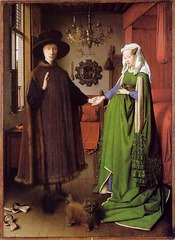
*: where there are orthogonal lines, they meet in general vanishing points rather than precise points, combined they draw our attention to the hands of the figures
*: no single element is subordinated to any other: incidental details such as the mirror on the wall or the window are works of art themselves
*: not perfect notion of perspective
*: subtle gradation of texture
*: the mirror brings a playful 3-dimentionality
*:
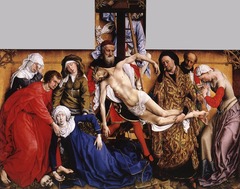
Descent from the Cross
1435-1438
oil on panel
*: all the figures are arranged parallel to the picture plane in a box-like space, like a painted version of a carved altarpiece,
*: the shallow space serves to emphasize the intense emotions of the scene, while Rogier’s graceful linear abstractions produce a painting which does not purport to depict reality
*: it is a sophisticated two-dimensional painting pretending to be a three-dimentional carved altarpiece
*: the tension between the picture surface and the illusionistic space so evident in Rogier’s painting was something that used to be characterized as the evolution of painting in the Netherlands in the first half of the fifteenth century. suggesting that the artists were thinking alongside the same lines as the Italians about the limitations of the picture plane
*: painting/sculpture ambiguity
*: the parallel between Jesus and the Virgin
*: set in a niche–fashion at that time
*: Gothic tracery elements
*: combination of profoundness and playfulness
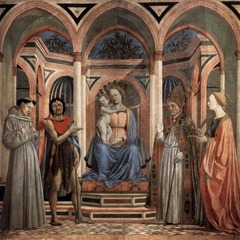
St. Lucy Altarpiece, 1450
*: the architectural space is constructed so that the orthogonal lines converge on a point between the Virgin’s knees.
*: altho the space appears convincing, the perspective construction is hidden, perhaps deliberately , by the use of curves and avoidance of obvious orthogonal lines
*: reconstructed in plan, the space seems unlikely because on a plan the gap between the Virgin and the architecture would have to be very wide for the niches to frame the different figures as they do.
*: Domenico’s intention seems to have been to create an image reminiscent of a more conventional polyptych in which all of the saints would have had their own separate panel
*: the tops of the front arches touch the edge of the picture as though they are meant to be read as part of the frame, although the bases of the columns occupy the pictorial space behind the saints
*: the central shell niche is positioned not so much to form a convincing interior but to frame the Virgin and Child
*: as a result Domenico has created an altarpiece that extends the conventional sacra conversazione with figures depicted in clear spatial relationship with one another and lit by a consistent light source
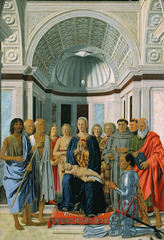
Madonna and Child with saints
1472-1474
*: pointing the child’s body to a certain direction to show his destiny
*: vanishing pointing on the Virgin’s neck
*: The background consists of the apse of a church in Renaissance classical style.
*: The Child wears a necklace of deep red coral beads, a color which alludes to blood, a symbol of life and death, but also to the redemption brought by Christ. Coral was also used for teething, and often worn by babies
*: The characters’ clothes, the angels’ jewells, Federico’s armor and the oriental carpet beneath the feet of the Virgin are depicted in great detail, reflecting the influence of Early Netherlandish painting.
*: The apse ends with a shell semi-dome from which an ostrich egg is hanging. The shell was a symbol of the new Venus, Mary (in fact it is perpendicular to her head) and of eternal beauty; in fact, differently from the Greek goddess, Mary’s beauty will remain eternal in the Kingdom of God.
*: The egg is generally considered a symbol of the Creation and, in particular, to Guidobaldo’s birth; the ostrich was also one of the heraldic symbols of the Montefeltro family.
*: Such an egg often hangs over alters dedicated to the Virgin.
*: It was believed that the ostrich let her egg hatch in the sunlight without intervention, and thus became a symbol of virgin birth. Also, the ostrich is here an absent mother, a symbol of the deceased Battista.
*: the artist’s mastery of proportions is remarkable; it is almost symbolized by the large ostrich egg hanging from the shell in the apse. The shape of this symbolic element is echoed by the near perfect oval of the Madonna’s head, placed in the absolute centre of the composition
*: In this painting Piero places his vanishing point at an unusually high level, more or less at the same height as the figures’ hands, with the result that his sacred characters, placed in a semicircle, appear less monumental.
*: Piero’s extraordinary invention of an architectural apse echoed below by another apse, consisting in the figures of the saints gathered around the Madonna, was taken up time and again by artists working at the end of the 15th century and at the beginning of the 16th, particularly in Venice, starting with the almost contemporary paintings of Antonello da Messina and Giovanni Bellini. This organized composition, typical of Piero’s work, contained within a unity of space and lighting, seems however to have a new feel about it, as though the artist were taking part in the new currents being developed in Italian art after 1470.
*: The new trends are dictated primarily by the great popularity that Netherlandish painting was enjoying, particularly in Urbino. The most descriptive and ‘miniaturistic’ aspects of Netherlandish painting are echoed in the Brera altarpiece in the Duke’s shining armour, for example, and in the stylized decoration of the carpet.
*: Netherlandish art was popular among the patrons of the period as well, as we can see by the rings on Federico’s hands, which Piero had painted by Pedro Berruguete, a Spaniard with a Northern training.
*: The angels’ garments are decorated with jewels and with huge precious brooches, their hair is held back by elegant diadems: these elements, and even their melancholy expression, are certainly influenced by the recent developments in Florentine art
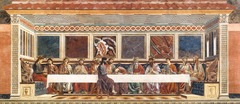
Last Supper
S. Apollonia, Florence
c. 1445-50
*: The arrangement of balanced figures in an architectural setting is particularly noted
*: Saint John’s posture of innocent slumber neatly contrasts Jude the Betrayer’s tense, upright pose, and the hand positions of the final pair of apostles on either end of the fresco mirror each other with accomplished realism.
*: The colors of the apostles’ robes and their postures contribute to the balance of the piece.
*: Andrea del Castagno (1423-1457) was well known for the emotional expressionism and naturalism of his figure style
*: balance between human figure and architecture
*: He portrayed movement of body and facial expression, creating dramatic tension.
*: Castagno brought to painting what Banco and Donatello brought to sculpture for Florentine artists. This influence carried great weight through the Renaissance, finding a masterful pinnacle in the work of Michelangelo.
*: the sobre architectural structure of the room where the scene of the Last Supper is taking place: a room in the austere style of Alberti, with the lavish coloured marble panels functioning as a backdrop to the heavy and solemn scene of the banquet
*: Notice also the beauty of some of the minor details, such as the gold highlights in some of the characters’ hair or the haloes depicted in perfect perspective.
*: The detail and naturalism of this fresco portray the ways in which del Castagno departed from earlier artistic styles. The highly detailed marble walls hearken back to Roman “First Style” wall paintings, and that the pillars and statues recall Classical sculpture and preface trompe l’oeil painting. Furthermore, the color highlights in the hair of the figures, flowing robes, and a credible perspective in the halos foreshadow advancements to come.
*: The treatment of the Last Supper was a serious challenge for Renaissance painters, who had to depict thirteen figures while retaining diversity and interest.
*: Castagno created an engaging space with imitation marble wall plaques and the sharply foreshortened floor and ceiling.
*: An extraordinary element of this fresco is the remarkable balance of gestures and expressions, particularly in the group of figures in the centre of the composition, where the innocent sleep of St John to the left of Jesus is contrasted to the tense, rigid figure of Judas sitting opposite.
*: Andrea del Castagno’s Last Supper (1447) is typical of the Early Renaissance. The use of linear perspective in combination with ornate forms such as the sphinxes on the ends of the bench and the marble paneling tend to detract from the spirituality of the event.

David
c.1450-1457
*: in the middle of motion
*: draped
*: Images of young David, who overcame seemingly insurmountable odds to kill the giant, were popular in fifteenth-century Florence, the smallest major power in Italy.
*: like many early Renaissance artists, Castagno has presented the action and its outcome simultaneously: David holds the loaded sling, but already the head of the slain Goliath lies at his feet. David’s energetic pose, based perhaps on an ancient statue, creates a strong contour that would have been clear and “legible” as the shield was carried. Nevertheless, the youth’s body is well modeled, rounded with light and shadow to give a convincing likeness of a body in action.
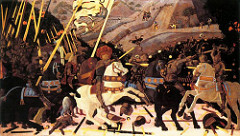
Battle of San Romano
c.1438
*: fallen weapons passing for perspective
*: set in a landscape
*: orthogonal grid
*: the central panel of a large triptych painted by Paolo Uccello
*: What makes this cycle a masterpiece is the bold and experimental use of the perspective who made Uccello famous.
*: The composition is very crowded, but despite that the atmosphere is somewhat unreal and the knights look like fake dummies of a medieval tournament. Paolo Uccello is more interested in the perspective and its application than in the human feelings.
*: The naturalistic details, the hunting scenes in the background, the finicky description of the armors and the horses remind us of the fairy-tale gothic aestethics.
*: Paolo Uccello is indeed an important transition artist, fully in love with the Renaissance revolution of Renaissance but winking at the gothic tradition.
*: Plastic shapes of the figures and horses march across a grid consisting of discarded weapons and pieces of armor; these objects form the orthogonals of a perspective scheme that is neatly arranged to include a fallen soldier;
*: a thick hedge of bushes defines this foreground plane, beyond which appears a landscape that rises up the picture plane, beyond which appears a landscape that rises up the picture plane rather than receding deeply into space;
*: spots of brilliant color and a lavish use of gold reinforce the surface pattern, which would have been more brilliant originally, as some of the armor is covered in silver foil that has now tarnished
*: Such splendid surface reminds us of the paintings of Gentile da Fabriano
*: Uccello’s work owes much to International Gothic displays of lavish material and flashes of natural observation, with the added element of perspective renderings of forms and space;
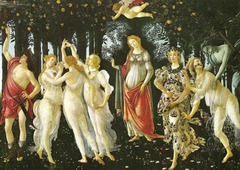
Primavera
c.1482
*: Among the many theories proposed over the last decades, the one that seems to be the most corroborated is the interpretation of the painting as the realm of Venus, sung by the ancient poets and by Poliziano (famous scholar at the court of the Medici). On the right Zephyrus (the blue faced young man) chases Flora and fecundates her with a breath. Flora turns into Spring, the elegant woman scattering her flowers over the world. Venus, in the middle, represents the “Humanitas” (the benevolence), which protects men. On the left the three Graces dance and Mercury dissipates the clouds.
*: The Allegory of Spring is a very refined work of art. The naturalistic details of the meadow (there are hundreds of types of flowers), the skillful use of the color, the elegance of the figures and the poetry of the whole, have made this important and fascinating work celebrated all over the world.
*: what is certain is the humanistic meaning of the work: Venus is the goodwill (the Humanitas), as she distinguishes the material (right) from the spiritual values (left). The Humanitas promotes the ideal of a positive man, confident in his abilities, and sensitive to the needs of others.
*: This ancient conception was on the way to Renaissance Humanism and Neoplatonic ideals moving around the Medici court. Neoplatonism was a philosophical and aesthetic movement trying to blend the thought of Greek philosopher Plato with the noblest concepts of Christianity. The Neoplatonic conception of the ideal beauty and the absolute love influenced the Renaissance culture and Botticelli.
*: Religion no longer needed to be the main subject of artist work.
*: This story alone shows that this painting was meant to celebrate a marriage
*: Also symbolic of love and fertility are the oranges growing in the grove. The Medici family had an orange grove on the family estate. The number of oranges Botticelli drew clearly represented the hope that this marriage would result in many offspring.
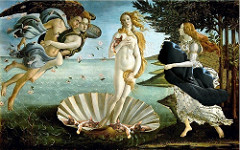
Birth of Venus
c.1485
*: Many aspects of Botticelli’s Birth of Venus are in motion. For example, the leaves of the orange trees in the background, ringlets of hair being blown by the Zephyrs, the roses floating behind her, the waves gently breaking, and the cloaks and drapery of the figures blown and lifted by the breeze.
*: Botticelli’s Venus was the first large-scale canvas created in Renaissance Florence.
*: He prepared his own tempera pigments with very little fat and covered them with a layer of pure egg white in a process unusual for his time. His painting resembles a fresco in its freshness and brightness. It is preserved exceptionally well and the painting today remains firm and elastic with very little cracks.
*: Birth of Venus is dependent on the delicacy of Botticelli’s line. The proportions show their greatest exaggeration, yet the long neck and torrent of hair help to create the mystifying figure.
*: open and deep tonality
*: the shallow modeling and emphasis on outline produce an effect of low relief rather than of solid, three-dimensional shapes. The bodies seem to be drained of all weight, so that they float even when they touch the ground
*: the ethereal figures re-create ancient forms

Delivery of the Keys
1482
*: As far as the composition is concerned, the most striking element is line, through which Perugino almost left us with a textbook case study of one-point linear perspective.
*: While the series of horizontal lines divide foreground from background, the diagonal orthogonal lines create the appearance of depth as they converge at the vanishing point near the doorway of the building in the background.
*: The result is that the scene takes place on what appears to be a large grid which allows viewers to quite clearly ascertain the distance between figures in the foreground, middle ground, and background.
*: In addition, Perugino used aerial perspective to make the hills on either side of the temple appear to fade into the background.
*: Both types of perspective help the viewer understand visually that the scene is anchored realistically in three dimensions, even though it was obviously painted on a two-dimensional picture plane.
*: In the fresco, Christ is shown in the middle, literally giving St. Peter keys (alluding to the “keys to the kingdom of heaven”), while the apostles stand in groups behind them.
*: Quite clearly, the handing of the keys to Peter is meant to frame the Catholic doctrine of apostolic succession by which Christ handed power to Peter, and hence onto the popes.
*: Christ and Peter are the figures of prime importance in this scene, and the importance of spiritual authority (embodied in the keys) is particularly emphasized by the key which hangs down vertically along the axis where the vanishing point is located.
*: The setting is a piazza, which is very spacious and airy. It is not a piazza from real life, but instead an idealized one with a temple in the middle of it. Aided by the grid-like ground pattern, we see separate groups of figures in the middle ground on both left and right sides of the piazza. These are scenes from episodes of the Gospels – one in which Christ says “render unto Caesar”, and the other in which the crowd is getting ready to stone Christ before he escapes.
*: The looming structures in the background are particularly notable. The temple is centrally-planned and domed, presumably with eight sides. For pilgrims visiting the Holy Land, the Temple of Solomon was thought to be associated with the Dome of the Rock in Jerusalem, and so what we are seeing here is based on a similarly octagonal and domed form.
*: On either side of the temple, monumental arches stand decorated with reliefs and gilded surfaces. These are triumphal arches of the kind built by the ancient Romans. These particular arches, however, resemble one very specific arch built in Rome around 312 A.D. – the Arch of Constantine, who reigned as emperor from 306-337 A.D. Constantine was the first emperor to legalize the profession of the Christian faith in the empire after centuries of Christian persecution by pagan emperors, and he was also the patron of the greatest churches of the late antique period. One of these churches was the (Old) Basilica of St. Peter, which became the seat of the pope in Rome. It was also thought that Constantine was the first to officially recognize papal authority. Again, this underscores the idea of papal authority.
*: Overall, the scene is one showing a critical Biblical episode for the popes, and one which makes excellent use of Renaissance perspectival devices to create the illusion of depth on a two-dimensional surface.
*: The style of the figures is dependent upon Verrocchio. The active drapery, with its massive complexity, and the figures, particularly several apostles, including St John the Evangelist, with beautiful features, long flowing hair, elegant demeanour, and refinement recall St Thomas from Verrocchio’s bronze group on Orsanmichele. The poses of the actors fall into a small number of basic attitudes that are consistently repeated, usually in reverse from one side to the other, signifying the use of the same cartoon. They are graceful and elegant figures who tend to stand firmly on the earth. Their heads are smallish in proportion to the rest of their bodies, and their features are delicately distilled with considerable attention to minor detail.
*: The gravely symmetrical design coveys the spatial importance of the subject in this particular setting: the authority of St. Peter as the first pope, as well as of all those who followed him, rests on his having received the keys to the Kingdom of Heaven from Christ himself
*: The figures have the crackling drapery and idealized figures of Verrocchio
*: HIghly individualized features
*: the gravely symmetrical design conveys the special importance of the subject in this particular setting: the authority of St. Peter as the first pope, as well as of all those who followed him, rests on his having received the keys to the kingdom of heaven from Christ himself. The figures have the crackling drapery and idealized figures of Verrocchio. A number of bystanders with highly individualized features witnessing the solemn event
*: in the vast background, two further narratives appear: to the left, in the middle distance, is the story of the tribute money; to the right, the attempted stoning of Christ; the inscriptions on the two Roman triumphal arches favorably compare Sixtus IV to Solomon, who built the Temple of Jerusalem. These arches flank a domed structure seemingly inspired by the ideal church of Alberti’s Treatise on Architecture,

Martyrdom of St. Sebastian
c.1450s
*: The idealized figure of the saint is set against a temple fragment painted with a masterly sense of the texture of both carved and broken rock. Mantegna juxtaposed the saint’s real foot with a foot fragment of a statue, playing on the paragone theme in a demonstration of the versatility of painting
*: The landscape background is close to that in the Meeting Scene in the Camera Picta, confirming the works’ chronological proximity.
*: The Roman martyr St. Sebastian almost resembles a stone sculpture here, and we experience first hand the rounded body contours achieved in the distinct moulding of the figure.
*: The background stretches forever behind the figure and is enriched with fragments of ancient architecture. Mantegnas signature on the column of the Triumphal Arch is written in Greek, more evidence of his extensive knowledge of the ancient world.
*: Firstly, Sebastian was given the designation as the patron saint of athletes because of his physical endurance and way of spreading the Faith. … In addition to the title of patron saint of athletes, Sebastian was named the patron saint of those afflicted with plague.
*: It is placed against a Corinthian column (with a glancing illusion to Vitruvius’s equation between architectural and bodily proportions). Yet in this, as in many other fifteenth-century religious pictures, the pagan world is shown symbolically in ruins.
*: Fragments of statues and reliefs lie on the ground, the building (based on the arch of Septimius Severus in Rome) is fissured and broken. The apparent contradiction is, however, essential to the meaning of the painting – Christianity, personified by the saint, prevails over all human ills and disasters.
*: St Sebastian was a patron of the sick and his intercession was evoked especially in times of plague, of which there were outbreaks (probably bubonic) every 15 years or so in Venice throughout the century.
*: anatomically precise and carefully proportioned – classical resonance
*: these forms are crisply drawn and modeled to resemble sculpture
*: signature in greek
*: a road leads into the distance, transversed by the archers who have just shot the saint; through this device, Mantegna lets the perspectively constructed space denote the passage of time
*: atmospherical landscape
*: later-afternoon sunlight: melancholy mood
*: the light-filled landscape in the background indicates Mantegna’s awareness of Flemish paintings, which had reached Florence as well as Venice around 1450
*:
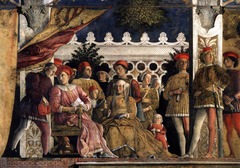
Duke Gonzaga of Mantua and his Court
Frescoes in the Ducal Palace, Mantua
1465-74

Oculus
Frescoes in the Ducal Palace, Mantua
1465-74
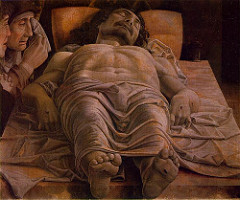
Lamentation over the body of Christ
c. 1480
*: Unlike most religious art of the Early Renaissance, this is not an idealized portrait of Jesus: the nail holes in the hands and feet, the discolouration of the skin, and the dramatic perspective of the foreshortened body lend it a coldness and a realism belonging to the mortuary slab.
*: A common theme in many religious paintings, the ‘Lamentation Over the Dead Christ’ is not a Biblical theme at all. It does not appear in any of the New Testament gospels, and only emerged as a devotional image during the 11th century.
*: His picture is defined from the outset by its window-like frame. This emphasizes the confined space of the scene and makes it appear even more like the cold slab of a morgue. It also gives the viewer, positioned at Christ’s feet, a dramatic close-up of Christ’s dead body: the physicality and naturalism are extraordinary – it looks completely lifeless.
*: The static nature of the body is further enhanced by a series of vertical and horizontal lines in the painting. The vertical ones comprise the position of the corpse, notably its arms and legs; and the right edge of the table. The horizontal ones are seen in the left/right axis of the pillow, the left/right flow of the shroud, and the bottom edge of the painting. These lines reinforce the stillness and immobility of Christ.
*: Within this grid however, Mantegna creates an illusion of movement, of life. The weeping Mary is dabbing her eye with a handkerchief; the damp, bloody shroud swirls across the lower half of the picture. Even Christ’s hair has a wild look. This contrasting appearance of motion helps to create a tension which attracts our attention, as do the elements which are visible only at second glance, like the face of Saint John (left edge), or the ointment container (top right).
*: This uncomfortably realistic representation of death, further enhanced by the picture’s muted colour scheme, and wax-like flesh tones, leaves no room for idealized musings or religious rhetoric. This picture is about the banal physicality of death – the end of earthly life. A fact and a prospect which is only relieved by our faith in God and a life after death. This may be the key message of the work.
*: Mantegna’s principal contribution to Early Renaissance painting was his mastery of trompe l’oeil spatial illusionism, exemplified by his foreshortening technique both in this painting and in his fresco painting on the ceiling of the Camera degli Sposi (room of the bride and groom) in the Ducal Palace, Mantua (1471-74). Foreshortening, namely the application of linear perspective to a single object or figure in order to simulate projection or depth (thus creating the illusion of three-dimensionality), helps to render the appearance of objects as we perceive them. Thus Mantegna’s Christ is shown greatly truncated, even though the artist had to deliberately reduce the size of the feet so as not to obscure our view of the body. If a photograph had been taken from the same viewpoint, the feet would have blocked our view of the torso.
*: The theme of the Lamentation is common in medieval and Renaissance art, although this treatment, dating back to a subject known as the Anointing of Christ is unusual for the period
*: Most Lamentations show much more contact between the mourners and the body. Rich contrasts of light and shadow abound, infused by a profound sense of pathos
*: The realism and tragedy of the scene are enhanced by the violent perspective, which foreshortens and dramatizes the recumbent figure, stressing the anatomical details: in particular, Christ’s thorax.
*: The holes in Christ’s hands and feet, as well as the faces of the two mourners, are portrayed without any concession to idealism or rhetoric. The sharply drawn drapery which covers the corpse contributes to the dramatic effect. Unique to this painting is a design that places the central focus of the image on Christ’s genitals – an artistic choice that is open to a multitude of interpretations. Mantegna managed instead to paint a very specific representation of physical and emotional trauma.
*: Mantegna presented both a harrowing study of a strongly foreshortened cadaver and an intensely poignant depiction of a biblical tragedy. This painting is one of many examples of the artist’s mastery of perspective. At first glance, the painting seems to be a strikingly realistic study in foreshortening .
*: Looking in we see an almost monstrous spectacle: a heavy corpse, seemingly swollen by the exaggerated foreshortening. At the front are two enormous feet with holes in them; on the left, some tear-stained, staring masks. But another look dissipates the initial shock, and a rational system can be discerned under the subdued light.
*: The face of Christ, like the other faces, is seamed by wrinkles, which harmonize with the watery satin of the pinkish pillow, the pale granulations of the marble slab and the veined onyx of the ointment jar. The damp folds of the shroud emphasize the folds in the tight skin, which is like torn parchment around the dry wounds. All these lines are echoed in the wild waves of the hair.
*: Mantegna’s realism prevails over any esthetic indulgence that might result from an over-refined lingering over the material aspects of his subject
*: His realism is in turn dominated by an exalted poetic feeling for suffering and Christian resignation
*: Mantegna’s creative power lies in his own interpretation of the “historic,” his feeling for spectacle on a small as well as a large scale. Beyond his apparent coldness and studied detachment, Mantegna’s feelings are those of a historian, and like all great historians he is full of humanity. He has a tragic sense of the history and destiny of man, and of the problems of good and evil, life and death.
*:
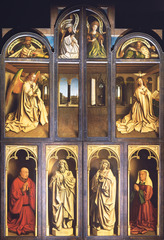
Ghent Altarpiece (closed)
1432
polyptych
*: subtle touches of color
*: marble statue kind of quality
*: four identical niches to indicate the architectural space
*: mortal patrons are signified as human forms instead of marble
*: but in here the patrons aren’t shown in perfect profile
*: infinite patience and attention to detail, gives the work its breathtaking technical virtuosity.
*: One of the greatest examples of early Flemish painting, the Ghent Altarpiece is acclaimed for its brilliance of colour and wide-ranging subject matter, which includes full-length nudes, vivid portrait art, landscapes, sumptuous robes and numerous examples of still life. Not for nothing did the great German master Albrecht Durer describe it as a stupendous piece of religious art.
*: Annunciation, underneath which are two remarkable grisaille panels containing illusionistic statues
*: These faux sculptures represent John the Baptist, holding the traditional symbol of the lamb, and John the Evangelist, author of the Apocalypse. Flanking the saints at each end, are separate paintings of the donor and his wife, Lysbette Borluut, kneeling in prayer. The whole visual effect is deliberately muted – only the portraits of the donors contain any real colour – probably in order to heighten the effect of opening the altarpiece to reveal the paintings inside
*:
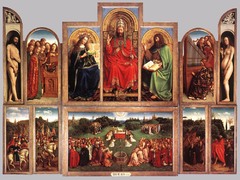
Ghent Altarpiece (open)
1432
polyptych
*: iconography: the lamb
*: very subtle light reflection and refraction on the crown
*: high naturalism seen in Adam and Eva
*: As soon as the polyptych is opened, the viewer is dazzled by an explosion of red and green colour pigments.
*: The pictures themselves are laid out in two registers or tiers. In the top tier, comprising three central panels and two wing panels at each end, we see an enthroned Christ the King, flanked by the Virgin Mary and John the Baptist. To offset the austere gravity of this central trio, they are flanked by paintings of angels singing and playing the organ
*: The angel’s clothes, instruments and surroundings are depicted in meticulous detail. Jan van Eyck’s masterly use of oil paint creates tiny vibrations of light within the dense, saturated colours, most of which are full of symbolic significance.
*: The beauty of the fabrics and the musical instruments demonstrate the creative capacity of man, which in turn alludes to the overarching role of the Creator himself. At either end of the upper tier, Van Eyck painted two stunning life-size portraits of Adam and Eve, depicted with extraordinary naturalism. These figures are among the most naturalistic of all male nudes and female nudes of the European Renaissance. They are surmounted by illusionist bas-reliefs featuring the sacrifice of Cain and Abel and the killing of Abel.
*: The centre of the lower tier, underneath the upper trio of Jesus, Mary and John, features a single large painting, from which the altarpiece takes its name. It shows the Eucharistic sacrifice of the Mystic Lamb (the symbol of Christ), placed on an altar surrounded by fourteen angels and set in a fertile meadow hedged with bushes, on the outskirts of a city. Four groups approach or occupy the meadow. Top left, we see a procession of bishops and cardinals. Top right, there approaches a group of female martyrs bearing palm leaves, symbols of their martydom. Bottom left, we see a group of kneeling Jewish prophets behind whom are a collection of pagan philosophers and scholars drawn from all over the world, as evidenced by their different styles of headgear. Bottom right, we see the twelve Apostles, followed by Popes and other clergy. Saint Stephen is shown carrying the rocks of his martyrdom.
*: All these groups look towards the altar in the centre of the meadow. The angels surrounding the altar hold the instruments of the Passion – the pillar against which Christ was lashed, the nails used to pin him to the cross, and the sponge dipped in vinegar. Blood is pouring from the lamb’s body into a chalice. And here we see the real meaning of the Ghent Altarpiece – sacrifice, blood, and the role of the clergy in administering the holy sacraments.
*: Situated in front of the altar is the ‘Fountain of Life’. Thin trickles of water fall into a channel which flows out of camera towards the viewer. The message is: the blood of Christ gives us life. Indeed a Latin inscription on the altar states: “Behold the Lamb of God who takes away the sins of the world.”

Man with a red Turban
1433
*: panel paintings
*: Van Eyck’s technical contribution to the art of oil painting – notably his meticulous use of thin layers of transparent colour pigments for maximum luminosity – made possible the precise optical effects and mirror-like polish that make this portrait so lifelike.
*: Note, for example, the effects of the two-toned stubble or the capillaries on the white surface of the left eye.
*: His use and application of colour has been commented on by numerous artists and critics: here, for instance, the white colour of the eye is mixed with tiny amounts of red and blue. A very thin layer of red is dragged over this underlayer, but in such a way as to leave the underlayer exposed in several places.
*: The iris of the eye is painted ultramarine – with additions of white and black towards the pupil, which is painted in black over the blue of the iris. The main highlights are four touches of lead white – one on the iris and three on the white.
*: The variation of focus between the two eyes suggests that Van Eyck, may have used a mirror to create this image: his right eye is slightly blurred around the edges, appearing to be only passivly engaged in sight, while the outline of the left eye is clearly delineated and focused on a specific object
*: This effect probably resulted from the artist observing himself in the mirror; when viewing oneself from an angle both eyes cannot be seen simultaneously.
*: Through his control of the medium, Van Eyck becomes ineffably present in the image, if not through his physical likeness, then through the way in which he alone has the skill to render invisible the mark of each brushstroke.
*: As in all his paintings, Van Eyck designs his composition with great care. Here, for instance, he relies heavily on colour and shade for effect. The rich red folds of the turban or chaperon frame and contrast with the lighted face which emerges from the darkness.
*: And the viewer is irresistibly drawn into the image by the firm gaze of the sitter, from which nothing else is allowed to detract. His use of chiaroscuro is masterly, as is his dramatic tenebrism. Van Eyck’s combination of tonal control and use of shading, anticipates the High Renaissance technique of sfumato, exemplified in the portraiture of Leonardo da Vinci (1452-1519).
*: Van Eyck uses light and shade in a subtle and dramatic way: the sitter seems to emerge from darkness, his face and headdress modelled by the light that falls from the left. The viewer is drawn towards the image by the penetrating gaze of the sitter.
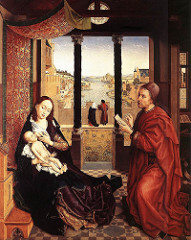
St. Luke drawing the Virgin (1435-1440)
*: In it Rogier exquisitely combined the Gothic legacy of stylized patterning with a new sense of naturalism
*: He did not, however, merely replicate the world around him, but manipulated details to create an intricate program of symbols.
*; For example, the enclosed garden in this painting refers to the Virgin’s purity while the carved figures of Adam and Eve on the arms of the throne symbolize Christ’s and Mary’s roles in redeeming humankind from original sin. Rogier may have modeled Saint Luke’s features on his own.
*: This work shares the solidity and monumentality of its figures with the Deposition (Prado, Madrid), but differs from it in a striking atmospheric effect of chiaroscuro, a quality typical of the art of Jan van Eyck.
*: As well as the ideas about the atmospheric use of light and shade that Rogier derived from this picture, he also adopted its overall construction and many motifs from Jan van Eyck’s painting, including the colours of the garments worn by the main figures. They are arranged in the picture as in the van Eyck model, except that the Virgin and her companion have changed sides.
*: In spite of the inspiration Rogier had gained from Jan van Eyck, his St Luke Madonna is an entirely independent depiction of the subject, and was to establish a new tradition.
*: in a departure from earlier paintings of the subject, Rogier’s saint is not himself painting the Mother of God but recording the silverpoint drawing. This corresponds to the practice of contemporary portraiture, and also emphasizes the spiritual significance of the picture more than the long, craftsmanlike activity involved in painting itself.
*: By comparison with other works by Rogier, the extremely picturesque qualities of the chiaroscuro in the St Luke Madonna are particularly marked. Perhaps the artist, impressed by this effect in the pictures of Jan van Eyck, used it here because the painting not only honoured the saint but also stood for the painter’s craft.
*: Rogier was demonstrating another modern artistic achievement, and thus – whether in homage or in a spirit of rivalry – was referring explicitly to the other famous Flemish painter of his time. On the whole, however, he interpreted his model very much in his own way: where Jan’s figures are embedded in a world of light and shade, Rogier’s figures clearly claim more attention than the rest of the picture. The landscape in the Rolin Madonna seems to stretch backward for ever, suggesting in its countless details the whole teeming fullness of the world. In Rogier’s picture it goes no further than its immediately visible part, and is cut off by architectural features at the sides; similarly the inner room, open to the elements in Jan’s painting, has acquired a ceiling in Rogier’s painting. The small town in the background is animated by little figures (including a man urinating outside the town walls) but it is possible to count them all – what is a whole universe in Jan’s painting here becomes a comparatively flat background for the figures, one that can be completely surveyed.
*: In those figures themselves, however, Rogier shows himself far superior to Jan van Eyck as an innovator. His Virgin is the quintessence of tender maternal love, simultaneously humble and proud; she is presented to the observer in such a way that (unlike Jan’s Madonna) she is effective even without the context of the picture, and may be seen as typical of representations of the Virgin by herself. Instead of the masses of folds in Jan’s painting, her garment in Rogier’s version of the scene forms attractive calligraphic patterns. St Luke is not kneeling motionless before her, absorbed in his work, but is approaching gently like the angel of the Annunciation. Although he is seen in the act of kneeling, it does not jar on the viewer that he could hardly execute a portrait sketch in that attitude, since his activity is not emphasized for its own sake. Instead, his mobile, sensitive hands express both veneration of the Virgin and the intellectual aspect of portraiture. The saint is deliberately captured in a state between movement and repose, which could be the reason why, by comparison with those in the Rolin Madonna, the figures have changed sides: the direction of the saint’s movement runs counter to the usual way of “reading” a picture (from left to right) and is thus inhibited – if St Luke were seen approaching from the left his movement would appear too emphatic.

Portinari Altarpiece
1474-76
*: Painted in Bruges then shipped to Florence, the panel paintings had a significant impact on Renaissance art in the city and beyond, including the Umbrian School of painting, as well as manuscript illustration.
*: The central scene celebrates the joy at the birth of Jesus, but also highlights the humility of the family and the peasants.
*: Three realistic figures of shepherds are kneeling before the Christ child, who – most unusually – is not lying in a crib, but on the ground, surrounded by golden light.
*: For his figures, Van der Goes introduces an old-fashioned hierarchy of scale: the Holy Family are given the largest dimensions, while angels and donors are smaller. The figures are arranged according to diagonal axes around the Virgin Mary, whose hands form the centre of the painting. This unusual arrangement produces a rather unbalanced sense of movement.
*: In the foreground, the exquisite still life – consisting of two vases of flowers and a sheaf of wheat – is a reference to the Eucharist and the Passion.
*: The wheat alludes to the Last Supper, when Jesus broke the bread. The vine leaves and grapes on the vase relate to the wine. The white irises symbolize purity, while the orange lilies refer to the Passion (the red carnations symbolize to the bloodied nails of Christ’s cross); the purple irises and columbine stalks represent the seven sorrows of the Virgin Mary. Thus, taken as a whole, this scene of Christ’s Nativity prefigures the later Salvation which he achieves through his death.
*: On the side panels, kneeling donors are flanked by their patron saints. Portinari, for instance, is shown on the left panel together with his two sons Antonio and Pigello. Opposite, on the right panel, his wife Maria di Francesco Baroncelli is portrayed together with their daughter Margarita. All the donors, with the exception of Pigello, are shown along with their patron saints: Saint Thomas (with spear), Saint Anthony (with bell), Mary Magdalen (with ointment) and Saint Margaret (with book and dragon).
*: The background of the triptych is painted with scenes related to the main theme. Thus on the left, we see Joseph fleeing to Egypt with his pregnant wife; in the central panel, the shepherds are visited by the angel; and on the right, the Three Magi are shown on their way to Bethlehem.
*: When the two side panels are closed, we see a view of The Annunciation, with the two figures – the Virgin of the Annunciation and the Archangel Gabriel – painted entirely in monochrome grisaille technique. The enormous figures, deceivingly rendered to resemble stone sculptures (hence the grisaille), are seemingly inset into their own austere arched recesses, and swathed in thick, flowing robes. The entire trompe l’oeil effect was something quite unknown in Renaissance art in Florence, and many Italian painters sought to imitate its meticulous naturalism. See for example the Adoration of the Shepherds (1485, Sassetti Chapel, Santa Trinita, Florence) by Domenico Ghirlandaio

Virgin and Child with patron portrait
1487
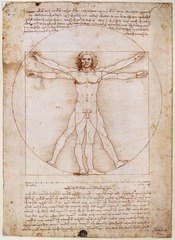
Vitruvian Man
1487
*: magnitude’ and ‘gravity
*: perfect example of Leonardo’s keen interest in proportion.
*: this picture represents a cornerstone of Leonardo’s attempts to relate man to nature
*: through his anatomical drawings and Vitruvian Man as a cosmografia del minor mondo (cosmography of the microcosm). He believed the workings of the human body to be an analogy for the workings of the universe.”
*: study of the male human proportions
*: This iconic image typifies the mix of science and art present in Leonardo’s vision of the world.
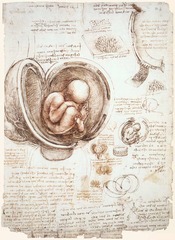
Embryo in the womb
1510
*: Leonardo’s philosophy of the human body was often represented by comparisons to architecture. His drawings followed rigorous techniques often employed by architects to depict three-dimensional views of his subjects. He viewed the body as an architectural masterpiece created by nature, in which the skeleton was akin to rocks that laid the foundation for the body.
*: Leonardo’s methods of accurately portraying human anatomy through drawings and diligently mapping out characteristics of the body are considered to have been the foundation of modern anatomical illustration
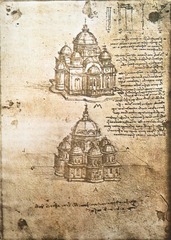
project for a church
1490

Portrait of Ginevra de’Benci
1474-1478
*: Young women of the time were expected to comport themselves with dignity and modesty
*: An early work, completed when Leonardo was 21, the painting shows an incipient genius and was revolutionary in the history of painting. One of Leonardo’s contemporaries wrote that he “painted Ginevra d’Amerigo Benci with such perfection that it seemed to be not a portrait but Ginevra herself.” Its lifelike and forthright portrayal broke with conventions of earlier Renaissance portraiture of women, including a preference for the more detached profile view. Ginevra de’ Benci is one of the first known three-quarter-view (a representation of a head or figure posed about halfway between front and profile views) portraits in Italian art. She eyes the viewer directly. The planes of her face subtly modeled, she may have “come to life” before viewers in a fashion more vivid than any other painting they had seen before.
*: The marble appearance of her complexion — smoothed with Leonardo’s own hand — is framed by the undulating ringlets of her hair. This then contrasts beautifully with the halo of spikes from the juniper bush. Leonardo veiled the background of this portrait in a thin veil of mist known as sfumato (literal translation: “turned to vapour”); this being created with overlaid oil glazes. Though Leonardo did not create this effect he become well-known for his skillful use of it.
*: Marriage portraits were a common practice at the time and most Florentine portraits of women were painted for just this reason.
*: The juniper plants are a symbol of chastity, highly appropriate for a marriage portrait, as well as being a pun — in Italian — on her name (the Italian name for juniper being ginevra).
*: the young woman stands before a thick hedge of juniper, which is a pun on her name; it is also a symbol of chastity
*: marriage or betrothal occasioned the painting of portraits of women, usually setting them in interiors, wearing expensive jewelry and garments, and often in profile arrangements. Da Vinci broke this mold by setting the young woman out of doors in an atmospheric landscape and in a three-quater view
*: Flemish portraits that had made their way to Florence probably inspired these choices
*: Flemish works definitely informed leonardo’s use of oil as the medium for his paintings
*: Leonardo’s landscape is much more believable and humid-looking.
*: He exploits the oil technique here to blend his brushstrokes very subtly so as to diminish the appearance of contour lines
*: his figures seem to exist only as the result of light falling on three-dimentioal objects
*: starting from a middle tone laid all over the panel, Leonardo renders deep shadows and bright highlights for his forms. In stead of standing side by side in a a vacuum, forms share in a new pictorial unity created by the softening of contours in an envelope of atmosphere.
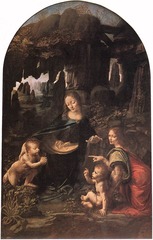
Madonna of the Rocks
1485
*: The Virgin of the Rocks is the first picture Leonardo is known to have produced in Milan and has stylistic similarities with works painted towards the end of his stay in Florence such as The Adoration of the Magi (Florence) and Saint Jerome (Rome), whose aesthetic concepts it develops. The rigorously ordered pyramidal composition does not hinder the movement of the figures, and the painstaking orchestration of their gestures (the superimposition of hands and interplay of looks) takes on a new intensity in the diffuse light which softens outlines without weakening the modeling of the figures.
*: The figures’ natural poses and the omnipresence of the predominantly mineral landscape are highly innovative compared to the affected architecture and hieratic poses of the altarpieces of the period. Yet it was not until 1501, when the cartoon of Saint Anne was first shown in Florence (see INV 776) that these principles were put into practice by other artists.
*: At the apex of the pyramid sits the Virgin or Madonna whose hand is raised, palm-down, over the head of the infant Christ, as if giving him a blessing. Gabriel’s hand, which is pointing to the infant John, forms a horizontal line in the space between the Virgin’s hand and the head of Christ, as if completing an invisible cross.
*: Meanwhile the Christ Child tiny right arm is raised in a gesture of benediction, aimed at the infant Saint John, who clasps his hands in prayer. The circle is completed by the Madonna who extends her arm to encircle the head of the infant John.
*: Leonardo’s handling of light and shade – arguably his greatest single contribution to High Renaissance painting – is almost faultless. The figures project out of the darkness of the grotto, illuminated by light falling from the top-left of the picture. The resulting chiaroscuro enhances the solidity and three-dimensionality of the figures, whilst Leonardo’s mastery of sfumato ensures that the edges between the illuminated and shadowy areas of the figures’ faces and bodies are rendered with the greatest possible reality. This naturalism marks a highpoint in Leonardo’s painting, but signals his abandonment of the style of Renaissance art in Florence – that is, the expressionist method championed by Botticelli (see La Primavera (c.1482-3) or the Birth of Venus (1484-6), both in the Uffizi), in which anatomical accuracy is sacrificed for artistic effect.
*: The raised linear perspective, by which the illusion of depth is given to the painting, is created by means of a contrast between the jagged black rocks in the grotto and the hazy profiles of the mountain tops in the far distance – a not inconsiderable feat, given the narrow tonal range of the monochrome background.
*: The setting of a rocky den is a perfect image by which to evoke the notion of natural motherhood. In the candlelit church of San Francesco Grande, the glittering frame together with the dark rocks of the picture, from whose shadows the holy figures emerge, would have combined to suggest a primordial cave, an ideal setting for the mystery of the Immaculate Conception
*: fantastic quality of imagination
*: natural architectural construction in the form of a canopy
*: early use of oil painting
*: Ieo explored the form of oil painting to its full potential
*: transparent glazes and atmospheric effects
CHIARASCURO
SFUMATO
*: lack of linearity compared to the works by Botticelli
*: mysterious scene
*: secluded rocky setting, the pool in the foreground, and the carefully rendered plant life suggest symbolic meanings
*: The figures emerging from the semidarkness of the grotto, enveloped in a moist atmosphere that delicately veils their forms.
*:The fine haze of Sfumato lends an unusual warmth and intimacy to the scene. The light draws attention to the finely realized bodies of the children and the beautiful heads of the Virgin and the angels.
*: Leonardo arranges the figures into a pyramid of form, with the figures establishing a solid geometric shape in space which has the Virgin;s head at the apex.
*: As a result, the composition is stable and balanced, but the gestures lead the eye back and forth to suggest the relationships among the figures. The selective light, quiet mood, and tender gestures create a remote, dreamlike quality, and make the picture seem a poetic vision rather than an image of reality
*: the relationship between poetry and painting
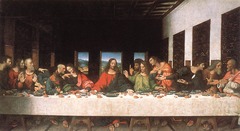
Last Supper
Maria della Grazie
Milan
1495-1498
*: Leonardo also simultaneously depicts Christ blessing the bread and saying to the apostles “Take, eat; this is my body” and blessing the wine and saying “Drink from it all of you; for this is my blood of the covenant, which is poured out for the forgiveness of sins” (Matthew 26). These words are the founding moment of the sacrament of the Eucharist (the miraculous transformation of the bread and wine into the body and blood of Christ).
*: Leonardo’s Last Supper is dense with symbolic references. Attributes identify each apostle. For example, Judas Iscariot is recognized both as he reaches to toward a plate beside Christ (Matthew 26) and because he clutches a purse containing his reward for identifying Christ to the authorities the following day. Peter, who sits beside Judas, holds a knife in his right hand, foreshadowing that Peter will sever the ear of a soldier as he attempts to protect Christ from arrest.
*: The balanced composition is anchored by an equilateral triangle formed by Christ’s body. He sits below an arching pediment that if completed, traces a circle. These ideal geometric forms refer to the renaissance interest in Neo-Platonism (an element of the humanist revival that reconciles aspects of Greek philosophy with Christian theology). In his allegory, “The Cave,” the Ancient Greek philosopher Plato emphasized the imperfection of the earthly realm. Geometry, used by the Greeks to express heavenly perfection, has been used by Leonardo to celebrate Christ as the embodiment of heaven on earth.
*: Leonardo rendered a verdant landscape beyond the windows. Often interpreted as paradise, it has been suggested that this heavenly sanctuary can only be reached through Christ.
*: The twelve apostles are arranged as four groups of three and there are also three windows. The number three is often a reference to the Holy Trinity in Catholic art. In contrast, the number four is important in the classical tradition (e.g. Plato’s four virtues).
*: In contrast to Andrea del Castagno, Leonardo simplified the architecture, eliminating unnecessary and distracting details so that the architecture can instead amplify the spirituality. The window and arching pediment even suggest a halo. By crowding all of the figures together, Leonardo uses the table as a barrier to separate the spiritual realm from the viewer’s earthly world. Paradoxically, Leonardo’s emphasis on spirituality results in a painting that is more naturalistic than Castagno’s.
*: Because Leonardo sought a greater detail and luminosity than could be achieved with traditional fresco, he covered the wall with a double layer of dried plaster. Then, borrowing from panel painting, he added an undercoat of lead white to enhance the brightness of the oil and tempera that was applied on top. This experimental technique allowed for chromatic brilliance and extraordinary precision but because the painting is on a thin exterior wall, the effects of humidity were felt more keenly, and the paint failed to properly adhere to the wall.
*: mathematical symbolism, psychological complexity, use of perspective and dramatic focus, make it the first real example of High Renaissance aesthetics.
*: In short, the painting captures twelve individuals in the midst of querying, gesticulating, or showing various shades of horror, anger and disbelief. It’s live, it’s human and it’s in complete contrast to the serene and expansive pose of Jesus himself.
*: As in all religious paintings on this theme, Jesus himself is the dynamic centre of the composition. Several architectural features converge on his figure, while his head represents the vanishing point for all perspective lines – an event which makes The Last Supper the epitome of Renaissance single point linear perspective. Meantime, his expansive gesture – indicating the holy sacrament of bread and wine – is not meant for his apostles, but for the monks and nuns of the Santa Maria delle Grazie monastery.
*: In most versions of The Last Supper, Judas is the only disciple not to have a halo, or else is seated separately from the other apostles. Leonardo, however, seats everyone on the same side of the table, so that all are facing the viewer. Even so, Judas remains a marked man. First, he is grasping a small bag, no doubt symbolizing the 30 pieces of silver he has been paid to betray Jesus; he has also knocked over the salt pot – another symbol of betrayal. His head is also positioned in a lower position than anyone in the picture, and is the only person left in shadow.
*: Leonardo employed new techniques to communicate his ideas to the viewer. Instead of relying exclusively on artistic conventions, he would use ordinary ‘models’ whom he encountered on the street, as well as gestures derived from the sign language used by deaf-mutes, and oratorical gestures employed by public speakers. Interestingly, following Leonardo’s depiction of Thomas quizzically holding up his index finger, Raphael (1483-1520) portrayed Leonardo himself in the The School of Athens (1510-11) making an identical gesture.
*: Laid out on the table, one can clearly make out the lacework of the tablecloth, transparent wine glasses, pewter dishes, pitchers of water, along with the main dish, duck in orange sauce. All these items, portrayed in immaculate detail, anticipate the still life genre perfected by Dutch Realist painters of the 17th century.
*: Leonardo’s meticulous crafting of The Last Supper, along with his skills as a painter, draughtsman, scientist and inventor, as well as his focus on the dignity of man, has added to his reputation as the personification of intellectual artist and creative thinker, rather than merely a decorative painter paid to paint so many square yards a day. This idea of the dignity of the artist, and the importance of disegno rather than colorito, was further developed by Michelangelo and others, culminating in the establishment of the Academy of Art in Florence and the Academy of Art in Rome.
*: The perfect balance between symmetry and variation
* : full grasp of human emotions and interactive response
*: evenly divided symmetry
*: traditional theme for monastic refectories
*: Like Castagno, Leonardo creates a spatial setting that seems like an annex to the real interior of the room, though deeper and more atmospheric than the earlier fresco
*: Symbolic: the opening of the wall behind Jesus: it acts as the architectural equipment of a halo: natural light
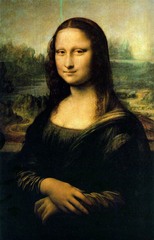
Mona Lisa
1503-1505
*: simple garments with landscape
*: half-length
*: renders the subtle movement of light washing over her figure to draw attention to her features
*: glaze: glowing effect
*: evocative background

Battle of Anghiari
1503-1506
*: the intense emotion of revolutionary quality
*: interactive figures consisting a cluster connected together instead of that of individuals in Uccello’s work
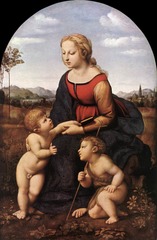
Madonna and child with Saint John(La Belle Jardinière)
1507
*: He could combine superhuman beauty with a human tenderness which was, in itself, as beautiful, and yet produced something which appealed to mankind as divine and altogether splendid. It is impossible to look into this picture and find any touch of sentimentality.
*: The delineation of each emotion in these faces is reasoned and honestly worked out. The expression of Son and Mother are, each in their different meanings, perfect, and the adoration on the face of the infant John, with his cross, is made almost adolescent because the artist wishes to convey the notion of worship in his picture. Indeed worship, or homage, is apparent in all three beauteous faces. Above the Virgin’s head a semicircle of clouds, which meets the curve of the top of the wooden panel in which the picture is painted, makes a kind of halo. The details of the landscape in the distances are touched with admirable restraint, and in no wise deflect the attention from the central interest.
*: interactive composition
*: full of harmony
*: atmospheric background landscape
*: lyrical and dramatic, pictorially rich and sculpturally solid
*: perfect bodies, graceful gestures, interaction
*: replaces the enigmatic gestures in The Virgin and the Rocks with a gentle, rhythmic interplay
*: Raphael substitutes for Leonardo’s intricate grouping a stable pyramid whose severity is relieved by Mary’s billowing cape
*: equally striking is the carefully observed landscape, whose bright light and natural beauty provide an appropriate setting for the figure group

School of Athens
stanza della Segnatura
1508-11
*: Plato points up because in his philosophy the changing world that we see around us is just a shadow of a higher, truer reality that is eternal and unchanging (and include things like goodness and beauty). For Plato, this otherworldly reality is the ultimate reality, and the seat of all truth, beauty, justice, and wisdom. Plato holds his book called the Timaeus. Aristotle holds his hand down, because in his philosophy, the only reality is the one that we can see and experience by sight and touch (exactly the reality dismissed by Plato). Aristotle’s Ethics (the book that he holds) “emphasized the relationships, justice, friendship, and government of the human world and the need to study it.”
*: Pythagoras (lower left) believed that the world (including the movement of the planets and stars) operated according to mathematical laws. These mathematical laws were related to ideas of musical and cosmic harmony, and thus (for the Christians who interpreted him in the Renaissance) to God. Pythagoras taught that each of the planets produced a note as it moved, based on its distance from the earth. Together, the movement of all the planets was perfect harmony — “the harmony of the spheres.”
*: This fresco – a masterpiece of disegno – represents natural Truth, acquired through reason. Under the arched vault of an immense Basilica with lacunar ceiling and pilasters, (inspired by Constantine’s in the Roman Forum), decorated with statues of Apollo and Minerva, a crowd of philosophers and wise men of the past, along with High Renaissance artists and patrons, argue heatedly among themselves or mediate in silence. An important feature of this work, as in all Raphael’s paintings, is the artist’s use of his Renaissance colour palette – in this case, to highlight certain characters and to control the attention of the viewer. See how certain hues act as reference points across the canvas.
*: geometrical harmony
*: monumentality&energy, ideology&realism
*: expressive energy, physical power, dramatic grouping of his figures
*: body and spirit, action and emotion are balanced harmoniously, and all members of this great assembly play their roles with magnificent, purposeful clarity
*: he further distinguishes the relationships among individuals and groups, and links them in a formal rhythm
*: symmetrical design
*: independence of the figures and their architectural setting
*: classical in spirit, Christian in meaning
*: humanism
*:

Galatea,
Villa Farnesina
Rome
1513
*: twisted/spiral serpent-like posture
*: cross of horizontal and vertical axis
*: The beautiful nymph of Galatea vainly pursued by the giant Polyphemus
*: The sensuality of the pagan spirit as if it were a living force
*: vigorously sculptural bodies
*: arranged in a dynamic spiral movement around the twisting Galatea
*: In Botticelli’s picture, the movement is not generated by the figures but imposed on them by the decorative, linear design that places all the figures on the same plane
*: Like Michelangelo, Raphael used the arrangement of figures, rather than any detailed perspective scheme, to call up an illusion of space and to create a vortex of movement
*: Raphael’s statuesque, full bodied figures suggest his careful study of ancient Roman sculpture which, like Michelangelo, he wanted to surpass
*:

Portrait of Pope Leo X with his nephews
1517
*: Leo, whose corpulent body and sumptuous dress are the only indications of the pope’s penchant for excess. He looks off into the distance, beyond the edge of the painting, and holds a magnifying glass while turning the page of his Bible. This gives the impression that he is reacting to someone who has just entered the room.
*: The poses of both other men indicate their relationships with Leo. Giulio stands on the left of the painting, looking out to the other direction; his posture and gaze mirror Leo’s. Giulio was considered a man of great authority, and was called by a Vatican chronicler, “Leo’s other self.” Luigi de’ Rossi, the pope’s cousin and best friend, is the only person who looks at the viewer, and his hands are touching the pope’s chair. The two had been raised together, and Leo was said to have been devastated after Luigi’s 1519 death of gout (an affliction that habitually plagued the Medici). The painting is dominated by red paint, the color of the papacy.
*: Some art historians have interpreted it as a dynastic portrait. Leo was the first Medici to attain the papacy, one of the most important offices in the entire world, and he quickly elevated his family members to high ranks within the Vatican. The Bible shown with Leo has been identified as a copy of the Hamilton Bible owned by Leo’s father, Lorenzo the Magnificent, indicating his Medici lineage. The bell on the table is a symbol of power, as it was used to summon servants, and is covered with Medici insignia, such as feathers, diamonds, and the Medici palle, or “balls,” which were the most recognizable symbols of the family. Some have suggested that the globe on Leo’s chair is also meant to recall the palle.
*: Most convincing is the suggestion that the portrait was made for religious purposes. In 1517, Martin Luther posted his 95 Theses condemning the abuses of the church, among which were the selling of indulgences, which Leo had used to fund the construction of Saint Peter’s Basilica. Although Luther would not split from the church for many years, the threat to the church was palpable. Art historians have noted that Leo is turning the page of his Bible from the last passage of the Book of Luke to the first of the Book of John. In Luke, Jesus is exhorting the Apostles to pray often in the Temple. This has been interpreted as a direct rebuke to Luther’s opposition to the building of Saint Peter’s Basilica. The Book of John begins, “There was a man sent from God, whose name was John. He came for testimony, to bear witness to the light, that all might believe through him.” Since Leo’s birth name was Giovanni (the Italian version of “John”), this scriptural passage can be understood to assert that it is only through the obedience to the pope, Giovanni de’ Medici, and official Vatican doctrines that one can achieve salvation. This is in direct contrast to Luther’s belief that salvation could be achieved through faith in God alone.
*: a masterful piece of realism.
*: The unflattering likeness of Leo, along with intricate details, such as the reflection of the interior of the room on the metal surface of the ball on the chair, show a complete mastery of the art of painting and a conception of naturalism entirely in keeping with the goals of the High Renaissance
*: ‘narrative’ portraiture, which set a new standard for other High Renaissance artists in Rome, Venice and Florence
*: A highly subtle piece of High Renaissance painting, this group portrait is designed around the dominant central figure of Leo X.
*: in contrast to the usual idealized features of his Madonnas and saints (see his Sistine Madonna), Raphael makes little attempt to idealize the short-sighted and overweight pontiff. Instead, he creates a more complex and realistic portrait, built on Leo’s gravitas and strength as a political as well as a clerical leader. His face and body dominate the painting, while his authority is subtly enhanced by the mood of respectful silence and sumptuous royal-red velvet robes. His two companions occupy subordinate positions, well in the background, although not so distant as to dilute the message of Medici power and authority. Indeed Cardinal Giulio de’ Medici has his hands firmly on the papal chair.
*: If Raphael hints at papal misdemeanors or general responsibility, he more than compensates by showing Leo as a serious-minded leader, unhindered by petty distractions. His eyes are fixed firmly ahead. It is regarded as one of the greatest portrait paintings of the 16th century.
*: rather than a spiritual being or a warrior, the pope is represented as a collector and connoisseur, shown examining a precious object
*: the simplicity and grandeur of the conception conveys the narrative in bold, clear terms that are only enhanced by the large scale of the bodies

St. Paul preaching
1515-1516
*:
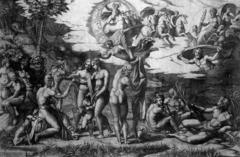
Judgement of Paris
engraving
1510-1520

Pieta
1498
*: This was a special work of art even in the Renaissance because at the time, multi-figured sculptures were rare. These two figures are carved so as to appear in a unified composition which forms the shape of a pyramid, something that other Renaissance artists (e.g. Leonardo) also favored.
*: An examination of each figure reveals that their proportions are not entirely natural in relation to the other. Although their heads are proportional, the Virgin’s body is larger than Christ’s body. She appears so large that if she stood up, she would likely tower over her son. The reason Michelangelo did this was probably because it was necessary so that the Virgin could support her son on her lap; had her body been smaller, it might have been very difficult or awkward for her to have held an adult male as gracefully as she does. To assist in this matter, Michelangelo has amassed the garments on her lap into a sea of folded drapery to make her look larger. While this drapery serves this practical purpose, it also allowed Michelangelo to display his virtuosity and superb technique when using a drill to cut deeply into the marble. After his work on the marble was complete, the marble looked less like stone and more like actual cloth because of its multiplicity of natural-looking folds, curves, and deep recesses.
*: In her utter sadness and devastation, she seems resigned to what has happened, and becomes enveloped in graceful acceptance. Michelangelo’s talent in carving drapery is matched by his handling of the human forms in the Christ and the Virgin, both of whom retain a sweet tenderness despite the very tragic nature of this scene. This is, of course, the moment when the Virgin is confronted with the reality of the death of her son. In her utter sadness and devastation, she seems resigned to what has happened, and becomes enveloped in graceful acceptance. Christ, too, is depicted almost as if he is in a peaceful slumber, and not one who has been bloodied and bruised after hours of torture and suffering. In supporting Christ, the Virgin’s right hand does not come into direct contact with his flesh, but instead it is covered with a cloth which then touches Christ’s side. This signifies the sacredness of Christ’s body. Overall, these two figures are beautiful and idealized, despite their suffering. This reflects the High Renaissance belief in Neo-Platonic ideals in that beauty on earth reflected God’s beauty, so these beautiful figures were echoing the beauty of the divine.
*: extraordinary virtuosity
*: deep undercutting
*: iconography
*: Virgin may be a symbol for the church itself
*: northern subject
*: Michelangelo depicts a mother’s lamentation over her dead son as a calm and transcendent moment rather than a tortured or hopeless one. The composition is stable
*:
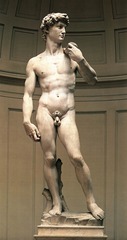
David
1501-1504
*: Thanks to its imposing perfection, the biblical figure of David became the symbol the liberty and freedom of the Republican ideals, showing Florence’s readiness to defend itself. It remained in front of Palazzo della Signoria until 1873, when it was moved into the Galleria dell’Accademia to protect it from damage and further weathering.
*: Micheangelo’s passion for the human anatomy and his deep knowledge of the male body.
*: Note the watchful eyes with carved eye bulks, pulsing veins on the back of the hands, engorged with tension. Admire the curve of the taut torso, the flexing of the thigh muscles in the right leg.
*: The proportions of some details are atypical of Michelangelo’s work. The figure has an unusually large head and imposing right hand.These enlargements may be due to the fact that the statue was originally intended to be placed on the cathedral roof line, so important parts of the sculpture had to be necessarily accentuated in order to be visible from below.
*: influence from Donatello
*: emblem of Republican virtues
*: the head of Goliath omitted
*: ideal but different from the wiry slenderness of Donatello’s youth
*: emotion-charged, muscular bodies of Hellenistic sculpture: Roman influence
*: heroic scale, superhuman beauty and power, swelling volume of forms
*: Michelangelo crafted the David to be at once calm and tense, active yet static, full of the potential for movement rather than its actual expression
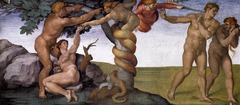
Temptation and Expulsion from Eden
Sistine Ceiling
1508-1512
*: The rhythm of the whole composition flows from left to right. Eve grasps the apple boldly, Adam greedily, but in misfortune he seems greater than the woman. He knows that through his fall God, who was near to him, has become inaccessible and remote. He almost disdains the garden of which he feels no longer worthy. In spite of rocks and the barren tree stump, Eden – the term signifies bliss – is too voluptuous and full of delight; the bodies are too plump and smooth, the foliage above their heads is almost too luxuriant. It is as though Michelangelo meant to say: ‘This is not yet the truth; that will have to be won in the desert of our destiny.’ It is, moreover, striking that the cherub with the raised sword pointing the way out, although in flight and strongly foreshortened, appears a twin of the tempter and, like her, issues from the tree (the Tree of Life; the Cabalistic Sephiroth). Good and Evil have divided and become a dual power. This idea, like nearly every fresco on the vault of the Sistine, is full of mysteries which, we now realize, have their parallels in artistic and structural mysteries. Everything connects in Michelangelo’s designs. In spite of their intellectual content, in spite of his humbly self taught knowledge, he never became literary; nor did he think in logical categories or in terms of dialectic, but visually and in symbols.
*: bold intensive hues and expressive body language that characterize the whole ceiling
*: figures are full of life, acting out their epic roles in sparse landscape settings
*: spiral composition
*: intense drama
*:

Creation of Adam
Sistine Ceiling
1508-1512
*: Unlike the figure of God, who is outstretched and aloft, Adam is depicted as a lounging figure who rather lackadaisically responds to God’s imminent touch. This touch will not only give life to Adam, but will give life to all mankind. It is, therefore, the birth of the human race. Adam’s body forms a concave shape which echoes the form of God’s body, which is in a convex posture inside the nebulous, floating form. This correspondence of one form to the other seems to underscore the larger idea of Man corresponding to God; that is, it seems to reflect the idea that Man has been created in the image and likeness of God – an idea with which Michelangelo had to have been familiar.
*: Michelangelo’s powerful image of this scene – showing the spark of life being passed from one outstretched fingertip to another – is a visual masterstroke. It has become an iconic image of Christian art, as well as a modern graphic for the transfer of physical and spiritual energy, and has an almost electrical magnetism.
*: Adam’s reclining, athletic figure – surely one of the most famous male nudes in art history – unites natural and ideal beauty, as Michelangelo’s precise anatomical rendition demonstrates the harmony in human proportions.
*: It is the first time in the history of art, that God has been painted in a horizontal position.
*: The major impression generated by this picture is the comparison between divine dynamic energy – illustrated in the illusionistic movement of the Creator who appears to radiate action – and human lassitude, represented by Adam’s aura of slothfulness. The contrast is encapsulated in the nearly-touching fingers of the two hands, as the spark of life is transferred to Adam. God’s index finger is fully stretched and tense with energy; Adam’s fingers so limp that they cannot even be fully extended. No image better sums up the physical and conceptual chasm between God and Man.
*: mighty physique and youthful face
*: tension&dynamics
*: expressive composition conveys a profound conception of the relationship between God and humankind
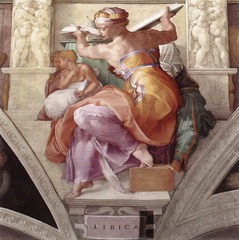
Libyan Sibyl
Sistine Ceiling
1508-1512
*: The vast symphonic structure of Michelangelo’s color is especially well seen in this illustration, ranging from the deep, rich tonalities of the spandrels and lunettes, intensifying the natural shadow of their positions, through the bright garments to the gray-white of the simulated marble. The figure is dominated by an orange-lavender dialectic of throbbing intensity. The bodice is orange, with white highlights and reddish shadows; the rose lining is turned up to reveal a lavender shift, always the color of divinity on the Ceiling, punctuated by hanging gray scarves. The border and the belt of the bodice are gray with gold-yellow buttons. The outer dress before which Libyca sits is a splendid green, with yellow-gold.
*: muscular forms
*:

Moses
Tomb of Julius 2
1513-1515
*: Under his arms he carries the tablets of the law—the stones inscribed with the Ten Commandments that he has just received from God on Mt. Sinai. You might marvel at Moses’ horns. This comes from a mistranslation of a Hebrew word that described Moses as having rays of light coming from his head
*: We can see the figure’s pent-up energy. The entire figure is charged with thought and energy. It is not entirely clear what moment of the story Michelangelo shows us. Moses sits with the tables of the ten commandments under his right arm. Is he about to rise in anger after seeing the Israelites worshiping the golden calf?
*: Moses is not simply sitting down; his left leg is pulled back to the side of his chair as though he is about to rise. And because this leg is pulled back, his hips also face left. Michelangelo, to create an interesting, energetic figure—where the forces of life are pulsing throughout the body—pulls the torso in the opposite direction. And so his torso faces to his right. And because the torso faces to the right, Moses turns his head to the left, and then pulls his beard to the right.
*: In Michelangelo’s dynamic figure of Moses we have a clear sense of the prophet and his duty to fulfill God’s wishes. Moses is not a passive figure from the distant biblical past, but a living, breathing, present figure that reflects the will and might of God.
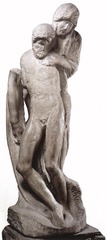
Awakening Prisoner
Tomb of Julius 2
1525
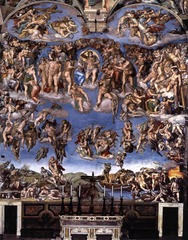
The last judgement
Tomb of Giuliano de Medici, S.
Lorenzo
Vatican
1534-1541
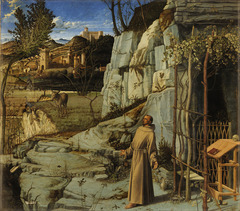
St. Francis in Ecstasy
1485
*: The landscape of Bellini’s desert is filled with marvelous details — animals, birds, persons, plants, objects such as the skull and sandals, and strange rock formations — that yielded hidden meanings for those who understood their importance in Franciscan literature. The water trickling from a spout in the stones at left, for example, is compared to the miraculous fountain Moses brought forth from the rocks at Horeb, and the empty sandals behind the barefoot saint recall God’s command to Moses to “put off the shoes from thy feet: for the place whereon thou standest is holy ground.” It is perhaps this sense of significance in all things as well as the radiant light flowing over the landscape that imbues the painting with such magical appeal.
*: A typically innovative example of Venetian painting by Giovanni Bellini, one of the greatest Old Masters of the Italian Renaissance,
*: the work is important for two reasons. To begin with, it is one of the first Renaissance paintings of stigmatization in which there is no sign of a seraph (angel or crucifix emitting rays). Second, it illustrates how Bellini combines the realism of Netherlandish Renaissance art, with the spatial depth of the Florentine Renaissance and the glowing colour palette used in both Venetian altarpieces and Venetian portraiture.
*: For the cultured nobility he painted top-quality landscapes, at first introducing a glimpse of a view behind sacred figures, later – as in the St. Francis – immersing them in it. For the less appreciative lower levels of the market, he trained the apprentices and pupils of his large workshop to produce endless variations of his serene compositions of the Madonna and Child.
*: The figure of Francis is deliberately made small in relation to the format, absorbed within God’s creation.
*: Bellini uses light to signal the reception of grace. The foreground of the picture – the place of penitence and meditation on Christ’s Passion – is dominated by a cool bluish-grey, while the saint and the distant landscape are warmed by the rays of the sun. The meaning emerges from the play of difference – cool and warm, barren and cultivated, bare and leafy. Behind Francis is his humble cell. Together with the Eucharistic vine above and the sepulchre-like cave behind, this side of the painting evokes the death of Christ on Good Friday. The left side, by contrast, evokes Christ’s rising from the dead at Easter: the sunlight, as it emerges from the clouds at the top right, inclines the laurel tree – token of Christ’s victory over death – towards Francis, as if in acknowledgment that the saint was another Christ.
*: This panel painting features several other symbols and motifs, often used in Flemish painting, involving plants, animals and other objects, which allude to Franciscan ideals of poverty and humility. They include: a skull (on the top of the saint’s reading desk) which not only evokes Golgotha but also represents the transience of human life, as compared to the eternal nature of God; the stream (left middle-ground) is intended to symbolize Moses and the great spring; the bare tree (centre) probably represents the Burning Bush; while the juniper shrub signifies chastity, and the grey heron symbolizes penitence because of its ash-coloured plumage. Meantime in the distance we can plainly see the still-empty Heavenly Jerusalem.
*: is a wonderful example of his style of painting. His eye for detail, for instance, and his meticulous life-like realism both stem from the works of Flemish painters like Jan van Eyck (1390-1441) and Roger van der Weyden (1400-64). His skill in creating the illusion of three-dimensional ‘depth’ or ‘perspective’ in the picture plane, comes from his knowledge of Italian Renaissance art in general, and the work of Andrea Mantegna, his brother-in-law, in particular.
*: synthesis of spatial systems, light and color into a wholly original image
*: miraculous light, symbolizing so intense that it illuminates the entire scene
*: background: magnificent expanse of Italian countryside
*: ample and intimate vista
*: a vision of natural beauty
*: deep space deriving from the rules of perspective
*: detailed textures and forms to populate the landscape
*: soft colors and glowing light infuse the painting with a warmth that makes such a solitary life not only bearable but enviable
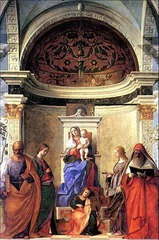
Madonna and Child with Saints
1505
*: The sacra conversazione, or “sacred conversation”, was a type of picture showing the Virgin Mary and the Christ Child among various saints from different periods of time. Sometimes these saints seem to communicate with each other, and sometimes with us, the viewers. Other artists, such as Domenico Veneziano, had depicted the sacra conversazione before, but Bellini treated his painting with a particularly high level of delicacy, vibrant colors, realistic forms, and illusionistic architectural space. In the San Zaccaria Altarpiece, the mood is one of quiet and restrained contemplation as all the figures are demure as they stand beside the Virgin and Child as the angel performs a serenade with a violin at their feet.
*: The scene type often shows an anachronistic gathering of figures who did not live at the same point in history. For example, in Bellini’s painting here, we see St. Peter (first century) on the left, dressed in his typical blue and orange robes, holding onto the keys with his left hand and the book in the right. Next to him is St. Catherine of Alexandria (fourth century), who is identified as a martyr by the palm branch she holds. We can tell this is St. Catherine because of the broken wooden wheel which appears by her side. According to the traditional story of Catherine, an attempt to kill her on the wheel was prevented when the wheel broke at her touch. She was later beheaded. On the right, St. Jerome (fifth century) is depicted reading a book, and next to him is St. Lucy (fourth century), known for having her eyes gouged out (presumably as a punishment for her Christianity).
*: The composition Bellini used for the painting draws upon the Renaissance tradition of pyramidal groupings of figures. Here, the most important figures are the Virgin and Christ Child, who form the apex of the pyramid. Elevated upon a throne, they are located further back in the picture plane than are the other figures. This intelligible use of pictorial space is made possible through the keen implementation of one-point linear perspective, the configuration of which is visually understood by following the orthogonal lines of the floor tiles to their vanishing point near the foot of the Virgin.
*: For Bellini, the painted, fictive architecture complements the high degree of realism and saturated colors to create a serene scene which is ripe for contemplation. Visitors to the church would be able to approach the side altar and experience the vivid depiction of all these holy figures through a type of “window” in the wall.
*: simpler but even more impressive setting
*: the figures are comfortably inserted into the apse in a stable pyramid composition
*: what distinguishes this altar from earlier Florentine examples is not only the spaciousness of the design but its calm, meditative mood
*: the figures seem isolated and deep in thought
*: the silence is enhanced by the way the artist has bathed the scene in a delicate haze
*: there are no harsh contrasts. light and shadow blend in almost imperceptible gradations, and colors glow with a new richness.
*: Bellini creates a glimpse of a heavenly court peopled by ideal figures in an ideal space
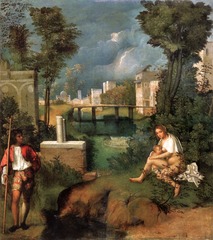
The Tempest
1505
*: that Giorgione began using a very fine chiaroscuro technique known as sfumato – the use of gradual shades of colour to express light and perspective. Vasari, who was notoriously biased in favour of the Renaissance in Florence, claims that the Venetian learned it from Leonardo’s works. In any event, use of the technique lent Giorgione’s oil paintings their characteristic glow.
*: work depicts a soldier and a breast-feeding woman on either side of a stream, surrounded by foliage as well as city rubble. In the distance a storm lashes the city.
*: the sensuous colours employed and the striking depiction of a natural atmosphere. Especially unusual is the quality of the light that suffuses the painting and falls on the figures, uniting the foreground and background elements. Unlike Florentine painting of the time, in which the background landscape functions purely as a believable backdrop or stage for the key figures, Giorgione’s landscape is an integral part of the work.
*: stormy landscape
*: enigmatic figures
*: verdant setting
*: humid atmosphere
*: atmospheric images that set a mood rather than convey a story
*: The Venetians valued light and color above all else to create their sensual images

Fete Champetre (pastoral concert)
1509-1510
*: Titian gives great weight to the landscape; it is not used as simple décor, but as a reflection of a certain state of mind. The search for balance is shown through the integration of these figures in a setting where man and nature must coexist in perfect harmony. This thought evokes the myth of Arcadia recounted in Virgil’s Bucolics and reinterpreted by the Neapolitan poet Jacopo Sannazzaro. The myth tells of the happy life of the shepherds of Arcadia, whose existence is centered around music and song.

Bacchanal (The Andrians)
1518
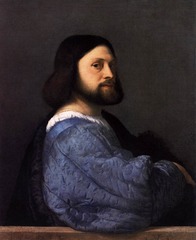
Portrait of a Man with a Blue Sleeve
1520
*: Within the broad stability of the pyramidal construction there is a highly sophisticated visual play of internal correspondences. The two great areas of light, the face and the costume, are each enframed by a darker element, which at once contains them and defines the larger silhouette of the figure. The fur-lined cloak draped with such studied casualness over the far shoulder creates a deep resonance of tone against which the satin sleeve is played off – as the profile of the cloak itself comments on the outline of the sleeve. The illuminated face of the sitter receives added strength from the dynamic profile of the surrounding hair and beard, which complement the larger shapes of the full figure.
*: If much of the impact of this portrait depends upon its large-scale relationships, these all serve to accentuate the psychological locus of the image, the highly articulate face and especially the direct encounter of those sharply alert and intelligent eyes. The very assertiveness of this entire configuration, the quality of the pose as well as the calm confidence of the physiognomic expression, has led to the tantalizing suggestion that this unknown sitter may in fact represent Titian himself. (An older identification as the poet Ludovico Ariosto has long been abandoned.) The picture was known to Rembrandt and Van Dyck in the seventeenth century, and did, indeed, inspire self-portraits by those masters.
*: eye-contact
*: commanding presence of the man’s projecting arm, which appears to reach out into a viewer’s space
*: His garment indicates his elite social status.
*: Titian records the textures of hair, cloth, and stone with great fidelity, all the while wrapping his figure in an atmospheric space through his use of chiaroscuro
*: Titian tries to record his personality as well as appearance
*: Titian’s career was to last long into the sixteenth century. His art is based on nature, whose likeness he records with great skill. He endows his figure with grace and personality, and wraps them in atmospheric light. Titian’s gift for compositions using naturalistic forms inspired by the ancient world make him a true representative of the High Renaissance.
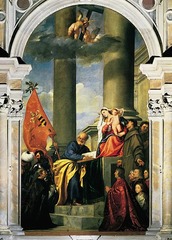
Madonna and Child with Saints and Donors
1526
*: he sets the Virgin and Child at he apex of a triangular arrangement of figures, but replaces the familiar frontal view with an oblique one that is far more active; The infant Jesus is as natural as the child in the Bacchanal, pudgy and innocently playing with his mother’s veil.
*: Titian places the Virgin’s throne on the steps of a monumental church. The huge columns, which are the key to the setting, represent the gateway to heaven, traditionally identified with Mary herself; the painting celebrates her as the Immaculate Conception, who was born without Original Sin. Because the view is diagonal, open sky and clouds fill most of the background. Except for the kneeling donors, every figure seems to move.
*: The design remains harmoniously self-contained, despite the strong drama, Brilliant sunlight makes every color and texture sparkle, in keeping with the joyous spirit of the altar
*: The only hint of tragedy is the cross held by the two little angels. Hidden by clouds from the participants in the sacra conversazione, it adds a note of poignancy to the scene
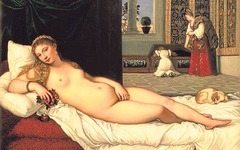
Venus of Urbino
1538
*: fully awake now and aware of her audience, she displays her charms in a deliberately public proclamation of love. Nudity, in the context of the interior setting and her jeweled adornment, is evidently not her normal state; she is, rather, naked, awaiting the garments that will clothe her.
*: This goddess clearly celebrates a different set of values, and her function, more social than poetic, is articulated by her surrounding attributes. She holds a bunch of roses, and on the window ledge in the background a myrtle plant, in perpetual bloom, is pointedly silhouetted against the glowing sky. These floral symbols, traditionally associated with Venus, define the very special kind of love she here represents: not merely carnal desire, but the more fruitful passion of licit love; not the quickly sated lust of the body, but the permanent bond of marital affection. The little dog curled up at her feet in contented slumber overtly symbolizes that ideal fidelity.
*: The evident eroticism of the painting, in fact, reminded the woman of the marital obligations she would have to fulfill to her husband. The erotic allegory is evident in the representation of Venus, the goddess of love, as a sensual and delectable woman staring at the viewer who could not ignore her beauty. The light and warm color of her body is in contrast to the dark background, bringing out her eroticism.
*: The dog at the feet of the woman is the symbol of marital fidelity while, in the background, the house maid looking down at the young girl as she rummages in a chest symbolizes motherhood.
*: It shows a nude young woman, reclining on a bed in the opulent surroundings of a Renaissance palace. Although the pose of the subject, identified as Venus, recalls that of Giorgione’s outdoor Sleeping Venus (which the young Titian had allegedly completed after Giorgione’s death) the intent behind it – as well as its detailed execution – is quite different. Titian has relocated Venus to an intimate, indoor setting, and made her look directly at the viewer – lending her a coquettish air in the process. Where Giorgione’s nude is idealized, unattainable and almost demure, Titian’s is both available and deliberately tempting. Indeed, the directness of Venus’s expression is unmistakable: she stares directly at the viewer, quite unfazed about her nudity.
*: The Venus of Urbino is full of artistic devices. To begin with, Titian achieves a beautiful contrast between the voluptuous curves of the girl’s body and the vertical and horizontal lines of the dividing screen, floor tiles and other architectural elements. In addition, the play of light on the girl’s body and Titian’s delicate chiaroscuro lends a sculptural quality to her figure, and also enhances the silky drapery of the bed sheets. The floor tiles provide extra linear perspective, while the floral patterns of the couch, cassoni, and background tapestry – in conjunction with the rich colour pigments of the screen and the maid’s costume – help to unify and activate the composition.
*: By the time he executed this work, Titian was established as the leading master of Renaissance art in Venice. Above all, he was known for his remarkable use of colour, and his works – which spanned all the major genres, including church altarpieces, mythological painting, portrait art, and pastoral landscape
*: Titian use of color records the sensuous texture of the woman’s body, which has been put on display
*:
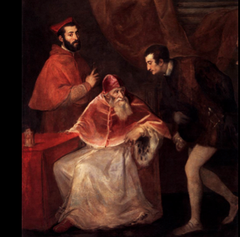
Pope Paul 3 and his Grandsons
1546
*: Aside from the colouristic magic that Titian creates with his rich, warm Renaissance colour palette, the work perfectly complements the earlier group portrait by Raphael (1483-1520) – Pope Leo X with Cardinals (Giulio de’Medici and Luigi de’Rossi) (1513-18, Palazzo Pitti, Florence) – which is another masterful representation of Papal power and character. Like many popes, Pope Paul III manages to have it both ways: he commissions a portrait of himself and his grandsons, while at the same time as he launches a worldwide propaganda campaign of devout Catholic Counter-Reformation Art to showcase a less corrupt Church.
*: Titian was the first painter for whom colour in painting was more important than any other aesthetic or painterly element. Not only are there very few examples of drawing by him, but also he uses colour to establish the setting, create atmosphere, and represent all the varying reflections of his subjects situations and personalities. In his oil painting, visible brush strokes and strongly textured surfaces replace the “smooth finish” required by the traditions of the High Renaissance. (Michelangelo, for instance, criticized the lack of disegno in Titian’s work, and its subordination to colorito, but complimented the Venetian’s colouring.) Titian became the acknowledged leader of Renaissance art in Venice
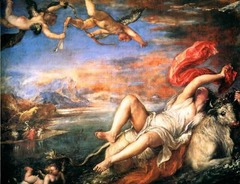
Rape of Europa
1559-1562
*: The Rape of Europa is a magnificent example of the master’s late “manner, loose in its painterly fabric yet satisfyingly finished in appearance; the subtlety and audacity of its suggestive brushwork offer a perfect correlative to the grave sensuality of its narration. Foreground objects are rendered with a thick impasto, strokes varied according to their different mimetic functions, while background forms, painted quite thinly, partake of the very texture of the canvas weave, which helps create a veil of atmospheric distance. On one level the picture is a demonstration of Titian’s full painterly power, and yet art somehow seems no longer to compete with art but rather to challenge nature herself, re-creating her models and informing them with a superabundance of her own organic stuff and energy.
*: rich colors and swirling movements to heighten the sensuous forms and to create an atmospheric setting for the events. His brushwork is very free, to the point that the forms are barely defined. This effect is enhanced by his use of the impasto technique. The sharp disjunction between foreground and background emphasizes the main figures’ distance from land and adds drama. Such images of sensuous interaction between gods and mortals offered artists like Titian an opportunity to compete with poets.
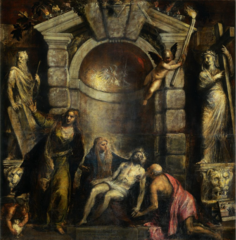
Pieta
1576
*: Poignance
*: The quiet, almost resigned mood is enhanced by the painting’s ethereal forms
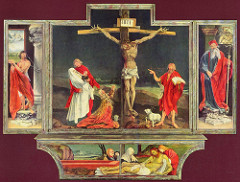
Isenheim Altarpiece closed
crucifixion, flanked by Sts. Sebastian and Anthony Abbot
1510-1515
*: Grünewald’s painted panels come from a different world; visions of hell on earth, in which the physical and psychological torments that afflicted Christ and a host of saints are rendered as visions wrought in dissonant psychedelic color, and played out by distorted figures—men, women, angels and demons—lit by streaking strident light and placed in eerie other-worldly landscapes. The painted panels fold out to reveal three distinct ensembles. In its common, closed position the central panels close to depict a horrific, night-time Crucifixion.
*: The macabre and distorted Christ is splayed on the cross, his hands writhing in agony, his body marked with livid spots of pox. The Virgin swoons into the waiting arms of the young St. John the Evangelist while John the Baptist, on the other side (not commonly depicted at the Crucifixion), gestures towards the suffering body at the center and holds a scroll which reads “he must increase, but I must decrease.” The emphatic physical suffering was intended to be thaumaturgic (miracle performing), a point of identification for the denizens of the hospital. The flanking panels depict St. Sebastian, long known as a plague saint because of his body pocked by arrows, and St. Anthony Abbot.
*: it is among the most famous religious paintings of the Northern Renaissance
*: A combination of Gothic art, powerful expressionism flavoured with Hieronymus Bosch-type imagery, and the latest Renaissance painting techniques, it was painted five years before Luther nailed his Protestant theses to the door of Wittenberg Cathedral in 1517, yet it perfectly captures the torment of the early 16th century.
*: Grunewald’s intensely realistic imagery and iconography were no doubt inspired by the revelations of St Bridget of Sweden, published in a best-selling devotional book during the 14th and 15th centuries. Although popular in the more down-to-earth north of Europe, they were less acceptable to the mainstream of the Roman Church in Italy, with the exception of austere fanatics like Savonarola (1452-98). In this sense, Grunewald’s tortured masterpiece is the polar opposite of contemporary Italian High Renaissance works such as Raphael’s graceful and harmonious Sistine Madonna (1513-14).
*: In this monumental work of Biblical art, Grunewald’s dark and harrowing portrayal of the Crucifixion shows a horribly wounded, twisted Christ, nailed to the cross. As one critic describes it: it is the most beautiful painting of ugliness in the history of art. Christ’s flesh bristles with jagged splinters, as well as the developing sepsis and necrosis. Paradoxically, his nail-pierced hands seem to acquire movement through rigor mortis. Jesus is flanked, on the left, by a kneeling Mary Magdalene and a grieving Virgin Mary being comforted by St John the Evangelist, and on the right, by John the Baptist. At the feet of John the Baptist is a lamb bearing a cross, whose blood flows into a goblet, symbolizing the union between the Old and New Testament as well as the redemption of mankind. (Compare Jan van Eyck’s Ghent Altarpiece, c.1432.) Below the Crucifixion panel, a predella represents The Lamentation.
*: This panel depicts the story of St Anthony who was attacked and so badly beaten by demons that his servant assumed he was dead and was about to bury him. But St Anthony regained consciousness and ordered his servant to take him back to his attackers so that he might receive more punishment. In the painting, he lies on the ground overwelmed by the ferocity of the devils, who are tearing his flesh with their teeth, claws and horns, until a brilliant light appears along with an angel sent by the Lord, to scatter his assailants and ease his pain. Inspired by the grotesque images of the earlier Dutch painter Hieronymus Bosch (c.1450-1516) and the Colmar engraver and painter Martin Schongauer (c.1440-91), Grunewald illustrated his story with numerous examples of bizarre monsters, including one or two decidedly humorous examples, showing that even angst-ridden German religious painters had their lighter moments.
*:heroic scale: dominating the image
*: despite the darkness of the landscape, an eerie light bathes the foreground figures to heighten awareness of them.
*:
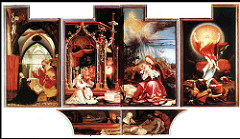
Isenheim Altarpiece open
Annunciation, Virgin and Child with Angels, Resurrection
1510-1515
Grunewald, detail of Virgin and Child from the Isenheim AltarpieceThe second position emphasizes this promise of resurrection. Its panels depict the Annunciation, the Virgin and Child with a host of musical angels, and the Resurrection. The progression from left to right is a highlight reel of Christ’s life.
*: All three scenes are, however, highly idiosyncratic and personal visions of Biblical exegesis; the musical angels, in their Gothic bandstand, are lit by an eerie orange-yellow light while the adjacent Madonna of Humility sits in a twilight landscape lit by flickering, fiery atmospheric clouds.
*: The Resurrection panel is the strangest of these inner visions. Christ is wreathed in orange, red and yellow body haloes and rises like a streaking fireball, hovering over the sepulchre and the bodies of the sleeping soldiers, a combination of Transfiguration, Resurrection and Ascension.
*: Grünewald saves his most esoteric visions for the fully open position of the altar, in the two inner panels that flank the central sculptures. On the left, St. Anthony is visited in the blasted-out wilderness by St. Paul (the first hermit of the desert)— the two are about to be fed by the raven in the tree above, and Anthony will later be called upon to bury St. Paul. The meeting cured St. Anthony of the misperception that he was the first desert hermit, and was therefore a lesson in humility.
*: In the final panel, Grünewald lets his imagination run riot in the depiction of St. Anthony’s temptations in the desert; sublime hybrid demons, like Daliesque dreams, torment Anthony’s waking and sleeping hours, bringing to life the saint’s torment and mirroring the physical and psychic suffering of the hospital patients.
Grünewald’s mastery of medieval monstrosity echoes and evokes Hieronymus Bosch and has inspired artists ever since. The entire altarpiece is a paean to human suffering and an essay on faith and the hope for heaven in the troubled years before the Reformation.
*: Grunewald links the panels through color and composition. other people’s, carefully arranged in a perspective display, contrast to the weightless and transfigured body of Christ
*: oil technique, his brilliant use of color, detailed rendering of objects from the Northern European tradition
*: the low horizon lines suggest a deep space for his figures and the rendering of the tomb from which Christ rises is a study in perspective
*: Grunewald doesn’t try to convince the viewer of the weight and substance of his figures; his aim is to create an emotional response with the impact of a vision.
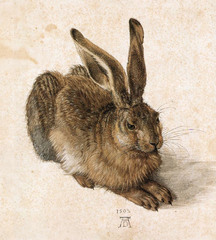
Hare
1502
*: The hare’s body is under painted and then plotted with wide brushstrokes, while individual hairs are executed with a greater variety of tones and delicate brushwork. The texture is so masterfully built up that you can almost feel the texture of the fur. Pay attention to hare’s ears perked up – another detail bringing the animal to life. Finally, the whiskers, claws and the reflection in the animal’s pupil bring the image to completion (or should we say perfection!)
*: It wasn’t until the 17th century that animals became a recognized genre in painting. In other words, very few artists addressed it until then, as many thought it couldn’t fully convey their artistic vision to public. Dürer was among the first artists to view animals as a subject that is actually worth attention and examination. The natural world and the fundamental truths it disguised captivated him and he probably created many of these images for pure enjoyment and out of curiosity. It was during the age of discoveries, when explorers were returning from distant lands to Europe bringing examples and illustrations of new species, sprucing interest in the world of animals and plants, both exotic and local. Young Hare and Durer’s other numerous paintings, drawings, sketches and prints, all demonstrate appreciation of fine detail and capture the structure and texture of a wide range of animals.
*: the clarity of his vision and the sureness of his rendering
*: watercolor used to render each hair of the fur, the curve of the ears, the sheen on the eyes
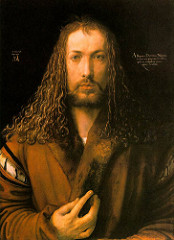
Self-portrait
1500
*: This portrait takes the form of a bust seen from a three-quarters angle against a dark background, and its composition is entirely consistent with the painting tradition of the time. The pose is a little awkward because the painter has constantly had to look at himself in the mirror. He is wearing sophisticated clothes: a little red cap with pompoms and an elegant overgarment of bluish gray which contrasts with the whiteness of the chemise with its wide embroidered neckline. The face still has some of the childish features seen in his early drawing of a Self-Portrait (1484, Graphische Sammlung Albertina, Vienna), but the manly neck, the strong nose, and the vigorous hands are already those of an adult. Dürer, who was also an excellent engraver, composed his works in a very graphic fashion. The almost metallic fineness of detail, seen in the prickles of the thistle, also recalls his early training as a goldsmith.
*: immense versatility and curiosity – enabled him to combine the detailed realism of Netherlandish Renaissance art with the disegno and the rules of beauty propagated by the Florentine Renaissance (1400-1500).
*: First, he wants to show that German traditions of painting can compete with the Italian Renaissance. (See also German Medieval art.) Choosing the genre of portrait art allowed him to show off his exceptional observational skills as well as his technical prowess at depicting textures (hair, beard, fur), eyes and hands. It also allows him to indulge his delight in mystical symbolism: – see, for instance, his initials AD, which are given added significance by being placed next to the date 1500, in imitation of the abbreviation “Anno Domini”. When he painted this work, Durer was 28 years old: and during the medieval era this age traditionally marked the transition from youth to maturity. The portrait therefore marks a key point in the artist’s life, as well as the start of a new millennium.
*: It is possible that Durer tried to transform his self-portrait into a work of religious art in order to elevate the debate about the status of artists (including himself) onto a higher plane. Religious paintings after all command extra respect in the spectator. Here, the frontal pose and the position of the hands (as though giving a blessing), are clearly reminiscent of the icon painting known as Christ Pantokrator (6th century, Monastery of Saint Catherine, Mount Sinai, Egypt), while the bearded face, the long hair and the stare, all recall pictures of Christ.
Self-Portrait with Fur Collar is the last of his three painted self-portraits. The other two are Portrait of the Artist Holding a Thistle (1493, Louvre, Paris), and Self-Portrait with Gloves (1498, Prado museum, Madrid), both of which focus on his youthful looks, hairstyle and fashionable clothing. The Pinakothek portrait is more serious, even sombre, and introduces a new introverted note. In addition to his painted self-portraits, Durer produced about ten self-portrait drawings and one gouache portrait (now lost).
*: solemn pose and idealization of features
*: iconic frontality
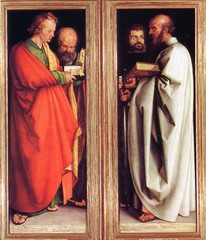
Four Apostles
1523-1526

The Four Horsemen of the Apocalypse
1498
*: In the text of Revelation, the main distinguishing feature of the four horses is their color; white for conquest, red for war, black for pestilence and/or famine, and pale (from ‘pallor’) for death (Clint Eastwood, Pale Rider, anyone?). The riders each arrive armed with a rather obvious attribute; conquest with a bow, war with a sword, and a set of balances for pestilence/famine. Dürer’s pale rider carries a sort of pitchfork or trident, despite the fact that he’s given no weapon in the Biblical account; he simply unleashes hell.
*: The quality of Dürer’s woodcut is breathtaking; one hears and feels the furor of the clattering hooves and the details, shading and purity of form are astonishing. Dürer’s unique genius as a woodcut artist was his ability to conceive such complex and finely detailed images in the negative—woodcut is a relief process in which one must cut away the substance of the design to preserve the outlines. Before Dürer it was often a rather crude affair. No one could draw woodblocks with the finesse of Dürer (much of the cutting was done by skilled craftsmen following Dürer’s complex outlines). The images are astonishingly detailed and textural, as finely tuned as drawings. So influential was Dürer’s graphic output, in both woodcut and engraving, that his prints became popular models for succeeding generations of painters. He was no mean painter himself, producing a varied and articulate array of self-portraits, as well as religious works, and turning his mind and his hand to the production of an influential book on perspective. He was a humanist, painter, print-maker, theorist and keen observer of nature and is therefore often referred to in popular discourse as the ‘Leonardo of the North’—although his actual output was considerably greater than that Italian Renaissance master.
*: sculptural quality
*: the physical energy and full-bodied volume of the figures in the Apocalypse series is partly owed to italian art. flatness
*: wide range of hatching marks, varied width of lines, and strong contrasts of black and white produce ambitious pictorial effects.
*: Durer enlarged the vocabulary of descriptive marks an engraver could use. The lines taper and swell, they intersect at varying angels; marks start and stop and dissolve into dots, called stipples. the result is a monochrome image with a great tonal and textural range;

Adam and Eve
1504
*: Despite the chill of the forest, the two human figures appear nude. Their bodies are frontal, and they stand in a classical contrapposto, or counterpoise, where the weight of the body is shifted onto one foot. The corresponding shift in hips and shoulders creating a convincing illusion of a body capable of movement but temporarily at rest. Despite this apparent naturalism, their heads are turned to the side as they gaze at one another. This twisting configuration of head and body is distinctly artificial. The naturalizing contrapposto clashing with the artificiality of the rest of the pose establishes a pattern of contradictions that run throughout the picture. A seemingly astutely observed tree becomes distinctly odd, as we recognize that Eve is plucking an apple from a tree with fig leaves. A parrot, a tropical bird, perches on a branch to the viewer’s left. Six other animals stroll disinterestedly through or stand about—an elk, ox, cat, rabbit, mouse, and goat.
*: Melancholic: elk, black bile
Phlegmatic: ox, phlegm
Sanguine: rabbit, blood
Choleric: cat, yellow bile
*: Dürer’s placid animals signify that in this moment of perfection in the garden, the human figures are still in a state of equilibrium. The cat does not yet chase the mouse, and the goat (a reference to the scapegoat of the bible) is still standing on his mountain perch.
*: The print allows Dürer to express his personal and cultural concerns. Proud of his German identity (Albert Dvrer Noricvs or “Albert Dürer of Nuremberg”), the artist is nonetheless enthralled by Italian and classical tradition. The German forest is ennobled by classically proportioned figures who actually reference Greek sculptures of Venus and Apollo, and anchored in tradition with the symbolism of the humors. In Renaissance fashion, the perfect physical proportions of the body correlate with the interior harmony of the humors.
*: The advent of mechanically reproducible media, both woodcuts and intaglio prints, was a revelation for Dürer and his entire world. Into a world where each image was handmade, one of a kind, and destined for one location, mechanical reproducibility offered something entirely different. Pictures made in multiples, such as the Adam and Eve engraving, meant that the ideas and designs of a German artist could be known in other regions and countries by large numbers of people. German artists could learn about classical art without traveling to Italy. More kinds of people could afford more pictures, because prints are easier to produce and typically less expensive than paintings. The traditional, direct contract between artist and patron, where one object was hand-produced for one patron and one place, gave way to a situation where multiple images could be seen by unknown viewers under an infinite variety of circumstances.
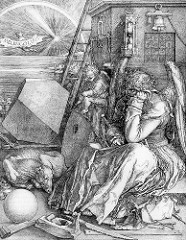
Melencholia
1514
*: Hammer: Carpenter
Compass: Mathematician
Putto with notebook: Grammarian
Keys: Power
Purse: Wealth
Bell: Eternity
Bat: Darkness. Boiled bats were recommended by the ancients as a remedy for melancholy
Wreath: Made from a plant which was believed to be a cure for excessive melancholy
Comet: Sign of Saturn, the god affiliated with melancholy
Magic square: Orderliness of numbers, each line (horizontal, vertical, diagonal) adds up to 34. Thought to be a talisman to attract Jupiter (The god who could heal the effects of Saturn)
1514: The year of the death of Dürer’s mother. Also the date of this print
*: A winged figure sits, brooding, her face in shadow but her eyes alert. She rests her head on her left hand and toys with a caliper (resembling a compass) in her right. A putto seated on a millstone writes on a tablet while below an emaciated dog sleeps between a sphere and a truncated polyhedron. Carpentry tools are scattered on the ground. A ladder leans against a building that supports a balance, an hourglass, and a bell. A magic square is inscribed on one wall; the digits in each row, column, and diagonal add up to 34. In the background, a blazing star or comet illuminates a seascape surmounted by a rainbow.
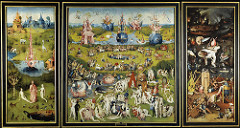
Garden of Earthly Delights
1480-1515
A tiny figure of God, holding an open book, is found in the uppermost left corner of the left panel, and the inscription that runs along the top of both panels can be translated to read “For he spoke, and it came to be; he commanded, and it stood firm,” which is from Psalm 33.9. If one thinks of the outside panels as the end of the entire pictorial cycle, rather than its beginning, then this image could easily be a depiction of the Flood, sent by God to cleanse the earth after it was consumed by vice.
*: Although they are precisely located in the centre foreground, in scale Adam and Eve—as well as God—are precisely as important as the other creatures in this paradisiacal garden, including an elephant, a giraffe (straight out of Piero de’ Cosimo) a unicorn and other more hybrid and less recognizable animals, along with birds, fish, other aquatic creations, snakes and insects.
*: The introduction of woman to man, in this setting, is clearly intended to highlight not only God’s creativity but human procreative capacity. In the hierarchy of God’s handiwork, Adam and Eve represent his most daring achievement, as though after he’d made everything else he thought he needed to leave a signature on the world in which he could recognize himself. It’s a matter of conjecture, when one proceeds to the central panel, as to whether Bosch is saying that the creation of man, on whom God conferred free will, might have been a divine mistake.
*: This is the panel from which the title Garden of Earthly Delights was derived. Here Bosch’s humans, the offspring of Adam and Eve, gambol freely in a surrealistic paradisiacal garden, appearing as mad manifestations of a whimsical creator—sensate cogs of nature alive in a larger, animate machine. It is a matter of divided opinion as to what, exactly, the humans are actually doing in this delightful, dense and nonsensical landscape, alive with a dizzying array of some of Bosch’s most delectable creatures and dotted with his alembic architecture. It is almost as though he imagined the world of creation as a terrific Willy Wonka series of machines with humans as their product.
*: Given Bosch’s emphasis on nude figures, some of which are engaged in amorous activities —although none in flagrante—this central scene has often been interpreted as a warning against lust, particularly in conjunction with the third panel, depicting Hell (the Spanish Hapsburgs, in fact, referred to the work as “La Lujuria” — lust). I wonder though. Bosch’s depiction of humans cavorting in the elemental world of God’s creation, seems, to me, less inculpatory than simply a commentary on the fact that there’s little to differentiate man from animals from plants.
*: Instead, what Bosch appears to be doing is contemplating man’s place in the greater divine machine of nature. Maybe he’s saying, as Lucretius did, that all matter is made of atoms that come together for a time to form a sensible thing and, when that thing dies, those atoms return to their origins to reconfigure in some other form. This breaking and becoming is the nature of nature, and man in nature, is not differentiated by anything OTHER than his free will, his concern for his own behaviour. Our reason is our undoing. Every man’s hell is only what he can imagine, and Bosch was more imaginative than most. His was a highly singular and idiosyncratic talent, and Bosch was really no more a product of his own time than he would have been of any other time. However, his ability to visualize hallucinatory landscapes made him extremely popular, three centuries later, with surrealists like Salvador Dali, who was also a virtuoso imagineer of nightmarish other-worldly worlds. I would venture to guess that Lewis Carroll must also have been a fan.
*: Against a backdrop of blackness, prison-like city walls are etched in inky silhouette against areas of flame and everywhere human bodies huddle in groups, amass in armies or are subject to strange tortures at the hands of oddly-clad executioners and animal-demons.
*: Dotted about are more crazy machine-like structures that seem designed to process human flesh. Some of these are strikingly disturbing. Near the center, a bird-like creature seated in a latrine chair, like a king on a throne, ingests humans and excretes them out again; nearby a wretched human is encouraged to vomit into a well in which other human faces swirl beneath the water.
In general, the bodies purge themselves or are purged of demons, black birds, vomitus fluids, blood; as in any good Boschian world, bottoms continue to be prodded with various instruments. But the general emphasis is on purgation.
*: Overall, there is a marked emphasis on musical instruments as symbols of evil distraction, the siren call of self-indulgence, and the large ears, which scuttle along the ground although pierced with a knife, are a powerful allusion to the deceptive lure of the senses. In fact, many of the symbols and the tortures here are pretty standard in the catalogue of the Seven Deadly Sins, in which our senses deceive our thoughts into self-indulgent over-consumption.
*: One key element here, however, requires some explication—the central, Humpty-Dumpty-ish figure who gazes out of the scene, his cracked-shell body impaled on the limbs of a dead tree. The art historian Hans Belting thought this was a self-portrait of Bosch, and a lot of people believe this, but it’s impossible to verify. Still, it quite strikingly illustrates the presence of a controlling, human consciousness in the centre of all this tortured imagining. And this is where my interpretation parts ways with those who have come before.
*: one of the most enigmatic and evocative religious paintings of the 16th century Netherlandish Renaissance.
*: the most bizarre, fantastical figures and surreal creatures.
*: depict sin and moral failing
*: The picture narrative begins on the outside shutters with the creation of the world; after the shutters are opened, the story continues, left-to-right, with the Genesis account of original sin, the proliferation of that sin during human life, and ends with images of the nightmarish penalties which the sinful can justly expect to receive in hell. Its fantastic iconography and modernistic images make it one of the greatest Renaissance paintings of the 16th century, and arguably the most inventive picture produced by Northern Renaissance artists in Flanders, Holland or Germany.
*: The left-hand panel shows God having made Eve out of one of Adam’s ribs, taken as he slept. God presents his creation to Adam, who has just woken up. They are in the Garden of Eden, but the pool before them is full of dark, slithering creatures, hinting at a dark future. The biblical image of Paradise being an enchanted garden is given a complete make-over by Bosch. Instead of fruit trees, Bosch’s Garden of Eden is full of real and imaginary creatures, lush meadows, anthropomorphic rocks, bizarre pastel-coloured rocky outcrops and strange pod-like objects. (Compare Michelangelo’s Garden of Eden, painted in his Genesis Fresco – one of the great Sistine Chapel frescoes, in the Vatican.)
*: The landscape continues into the central panel of this extraordinary painting, which suggests a natural progression from one sin to many. The name of the triptych comes from the garden in this central panel, which features cavorting nudes, giant birds, oversized fruit and several strange objects or contraptions. In the background is the Fountain of Flesh, where naked women seduce male riders who circle around them. It is the sinful counterpart to the Fountain of Life in the Garden of Eden. In general, the panel depicts mankind engaged in a range of depraved activities, all of which are clearly deemed sinful by the artist, who shows (in the right-hand panel) that they lead to the torments of hell. Symbolism is everywhere. The fruits, animals and exotic mineral structures in the background, for instance, have all been identified as erotic symbols based on popular songs, sayings and slang expressions of Bosch’s era. Thus plucking fruit or flowers was a metaphor for copulation, while the peelings, which the lovers find so fascinating, was a byword for worthlessness.
Curiously, the centre panel contains only young men and women: there are no children and no senior citizens to be seen. Also, the scene contains no focal point and no linear narrative, which enhances the overall mood of abandonment. Note the absence of God in this panel, which highlights what happens when mankind is given complete freedom. As we can see, under such circumstances, Bosch predicts a playground of corruption.
*: In the right-hand panel, Bosch’s hell (the only picture to be set at night) is divided into three levels or tiers: in the top tier, a ravaged landscape is lit by the macabre glow of an eerie fire. Huge crowds can be seen marching endlessly. In the middle level, Bosch has painted a mocking self-portrait, in the guise of a man/tree whose arms/roots are set in two boats. The hollow torso contains a sort of hellish tavern, frequented by resting ‘devils’. On his head is a rotating platform with a bagpipe – a symbol of evil and lust. Two enormous ears on the left are pierced by an arrow and cut by the blade of a knife. The contraption symbolizes Man’s deafness to the New Testament exhortation: “If any man have ears to listen, let him hear.” In the bottom tier, the guilty are confronted by their sins. Thus personifications of the Seven Deadly Sins are made to suffer. The vain woman is doomed to stare for eternity at her reflection in a demon’s rump; a glutton is forced to vomit into a pit; a miser is forced to excrete gold coins into a cesspool. Various musicians are tortured on gigantic versions of their instruments. Similarly, a hunter is impaled by a hare, while another is devoured by his own hounds.Neither beauty nor warmth are on show anywhere in this panel: a tone which reflects Bosch’s chilling view, that the guilty who have succumbed to the temptations of the devil must reap eternal damnation.
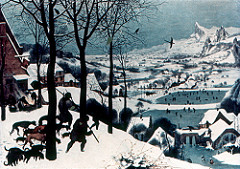
The Twelve months
Return of the Hunters
1565
*: These panel paintings did much to secure Bruegel’s reputation as one of the best landscape artists of Northern Europe. His unique contribution to the genre was to invest it with significant narrative on the rural mores and behaviour of 16th century Netherlanders. See also: Protestant Reformation Art (c.1520-170
*: Also called The Return of the Hunters, this Bruegel oil painting – which is, incidentally the world’s most popular classical Christmas card design – evokes the harsh conditions and temperatures of winter. In the foreground, three hunters are depicted returning from a hunting expedition with only a fox, to show for their effort. They and their dogs appear exhausted as they pass a small group of peasants “singeing” a pig to remove its bristles. The valley occupies the middle ground of the picture, frozen ponds and fields are dotted with skaters, while icicles hand from the mill wheel to the right. Bare trees litter the landscape. Fringed with mountain foothills and a cluster of jagged peaks (based on sketches made during the artist’s 1552-3 trip through the Alps), the valley stretches as far as the horizon, populated by small villages laid out in the frozen flatlands. The entire scene is characterized by Bruegel’s chilly colour scheme of pale green sky and ice, along with muted white snow – both set off by the dark browns and blacks of the trees, birds, dogs and people. (See also Renaissance Colour Palette.) It is a cold, gloomy late afternoon in winter – the season of barren earth, sleep and death.
*: The composition is ideal as the first in a frieze of pictures covering the full year. Trees on the left make an ideal framing device, while the hunters intended path down the hill into the valley to the right leads the viewer easily into the rest of the “Months”. In addition, the line of trees and the line of houses – both of which begin in the left-hand foreground and then follow the left-to-right downward slope of the hill – automatically give the picture instant depth. A further line of trees enhance the linear perspective by leading the viewer’s eye into the centre of the valley. In fact, the whole picture is effectively structured around two main diagonals formed by (1) the left-to-right line of hunters, trees and left-hand edge of the frozen ponds/fields; and (2) the right to left line formed by the trees running along the base of the hills and peaks.
*: As usual for a Bruegel, the painting is filled with detail. See, for instance, the tree branches ‘dusted’ with fine snow; the Inn sign inscribed with the words “Under the Stag” and an image of Saint Eustace; figures tobogganing, curling and spinning tops in the ponds; the firemen extinguishing a chimney fire; people shooting birds; the watermill with its frozen water wheel; and the village church steeples providing visual reference points in the far distance.
*: Most of Bruegel’s landscape and genre painting follows in the broad tradition of Hieronymus Bosch (1450-1516). Thus his art is rarely if ever devoid of religious significance. The meaning of Hunters in the Snow is simply that the man himself is a powerless entity, of no consequence, who is at the mercy of the natural seasons and rhythms of the year. The implication is, that only faith in the Creator and the natural (divine) order can bring us meaning and comfort. This is a low-key example of religious art, which – like a good deal of Netherlandish art of the 16th and 17th century – provides a very ordinary (even secular) setting, for its message.
*: nature as setting for human activities
*: a shelf of space in the foreground that moves precipitously into the distance toward a far horizon
*: human activities are fully integrated into the natural landscape
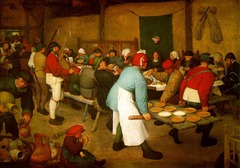
Peasant Wedding
1568
*: the work exemplifies the artist’s late-style, with its use of monumental Italianate figures. It was pictures of this type which gave rise to his nickname ‘Peasant’ Bruegel, although research makes clear that he was an active member in humanist intelligentsia circles in Antwerp, which was an important centre for Northern Renaissance artists in Flanders. While some of its content remains obscure, like nearly all Bruegel’s paintings, The Peasant Wedding contains numerous symbolic references as well as a clear moralistic undertone. The work is one of several panel paintings by the artist which are held by the Kunsthistorisches Museum in Vienna.
*: The wedding banquet is shown taking place in a barn in springtime. The furnishings are a parody of a rich landowner’s hall. In place of a finely woven tapestry, an old blanket hangs from the wall behind the bride. The wooden tables and chairs are roughly fashioned, while an old door has been taken off its hinges to serve as a banqueting tray. The main foods on offer appear to be bread, porridge and soup. Two ears of corn on the wall, together with a rake, are conspicious reminders of the hard grind to which peasants are born. On the left, two pipers are playing the pijpzak, while on the right the most distinguished-looking guest is sitting on an upturned tub.
*: According to Karel van Mander’s Lives of the Netherlandish Painters (Het Schilderboeck, 1604), Bruegel would often mingle with the crowd at a rural fair or village wedding, making drawings of the people and their way of life, which he would later use in his landscape painting and religious art, as well as his genre works. And indeed, this picture has traditionally been regarded as a straightforward portrayal of peasant life. However, Bruegel injects the scene with an unmistakeable moral judgment – highlighting the fact that the marriage celebration has deteriorated into gluttony and self-indulgence. In contrast to his earlier engraving of The Vices (1556-57), which Bruegel populated with grotesque figures in the manner of Hieronymus Bosch, The Peasant Wedding is a far more naturalistic, even mundane commentary.
*: italian perspective
*: precise and detailed
*: weight and solidity that adds to the impression of reality
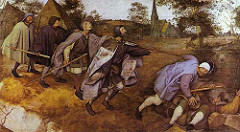
The Blind leading the Blind
1568
*: this large painting shares an aversion for strong colour and a corresponding preference for delicate tints such as mauve, grey, a subdued green and dun
*: The inevitable fall is expressed by the one great descending diagonal of the victims heads and arms sustained throughout the picture and underlined by parallel and reinforcing diagonals in their wooden crutches and in the sloping ground. The weaker counteracting diagonals, necessary for a formal equilibrium even in the most expressively constructed compositions, are provided by the slanting bodies themselves, the second staff from the left, and the pathetic little bare shrub at the lower left.
*: No less important in producing the impression of a hopeless fall are the vertical and horizontal lines in the background provided by the meadow, the gently curving hill, the trees and the church; they mark the necessary contrasts to the diagonals while the conical forms of the houses on the left support the development of the diagnonals in the procession which issues from them. But there is more. A straight uninterrupted diagnonal would not only be dull and pedantic in form, but would also miss the tension, the breathtaking drama which the story contains. While the leader already lies prostrate in the ditch and the one next to him is clearly doomed, there seems to appear a flickering ray of hope for the rest, expressed by an interval without fall – an interval which for a moment even seems to receive sanction by the contrasting sturdy vertical of the church. But the forefold forward bend of the men approaching from the left destroys that futile hope, and the pathetic upward tilt of the heads of the leading men of that group reminds us – rather conveys to us optically – that, being blind, they cannot even fathom what is going on in front, and are therefore destined to share the fate of their leaders.
*: visual interpretation of verbal wisdom

Descent from the Cross
1521
*: eposition from the Cross depicts the moment, recounted in the gospel, when the followers of Christ remove His body from the crucifix. The cast of characters involved generally includes Joseph of Arimathea, (the man with the grey beard) Nicodemus, (reaching out to support the body) St. John the Evangelist, (the red-headed man stooped in grief) the Virgin Mary, and Mary Magdalene (at the bottom throwing herself at Mary’s feet).
*: The upper figures are frozen in a moment of frenzied, grief-laden activity, carrying the body precariously down from the cross. The lower figures seem to exist almost in another reality, serving as symbols of anguish, devoid of the activity suggested by the upper half of the tableau.
The tall figure with red hair, traditionally St. John, is widely considered to be a self-portrait of Fiorentino. By including himself in the composition he becomes part of the emotional intensity of his own work. The position he is in, stooped over in anguish with his head buried in his hands, accentuates this.
*: The colors in Deposition from the Cross are bold, dramatic and dissonant, inspiring feelings of horror and grief. The body of Christ is a sickly green hue, his reddish hair clashing with the cadaverous tones of his skin.
*: Where previous depictions of the Deposition tended to focus more on the scene itself – the action, the background, and often idealized figures – Fiorentino’s work focuses solely on emotion.
The background is practically nonexistent, channeling all of the viewer’s energy on the figures stopped in their tracks.
*: The harsh and unnatural lighting seems to come from a flash from above, freezing the participants in a snapshot moment in time.
*: By this point in his career Fiorentino had mastered the art of detail, which is apparent in the figures’ expressions. The oil paint is applied in light strokes, creating a smoothness of texture and subtle layered effect.
This technique was seen frequently with Florentine painters, in contrast to the thicker paint application typical of the Venetians.
*: lack of a cross or any other indications of a specific narrative, so its subject is unclear, although the chapel’s dedication points to the Pieta. Unlike Rosso’s elongated form, Pontormo’s figures display an ideal beauty and sculptural solidity inspired by Michelangelo, yet Pontormo has squeezed them into an implausibly confined space
*: In portormo’s painting, everything is subordinated to the play pf graceful rhythms created by the tightly interlocking forms. The colors are desaturated: pale blues, pinks, oranges, and greens that may have been inspired by the colors of the Sistine Chapel ceiling.
*: Although they seem to act together, the mourners are lost in a grief too personal to share with one another. In this hushed atmosphere, anguish is transformed into a lyrical expression of exquisite sensitivity.
*:

Deposition
1526-1528

Self-portrait
1524
*: It shows us the self-examination and exploration processes that the artist must go through in order to channel their creativity. Parmigianino has created a different sense of reality in his painting, something which is shifting, distorted and unruly. He plays out a different divide between the material and the spiritual, the viewer and the artist.
*: He looks dreamy, angelic and full of aspirations; his face so smooth and fair that he looks more feminine than masculine and perhaps more divine than human.
*: contemplative but there is also an emphasis placed on his hand and it is this which dominates the foreground of the picture.
The artist’s hand perhaps represents the manual and technical skill that he deicated to his work. However, his head is also illuminated and central to the picture’s composition, stressing the importance of learning and the philosophical nature of the artist.
*: Many Mannerist artists, including Parmigianino, were keen to exploit and employ differing perspectives and conflicting spaces; they dismantled the Renaissance works that promoted a sense of orderly space
*: The colors in the painting are pale and muted, not bold or life-like, which adds to the sense that we are looking at a reflection of the artist in the mirror. He has not only managed to study himself in a convex mirror, but has reproduced exactly what he saw in it. The viewer is made to believe that they are looking at his image reflected in the mirror and not a surface created with paint and brushes.
*: mannerism
*: smooth perfection
*: delicate sfumato
*: The composition is as unbalanced as the posture: heavily weighed to the left, open and distant to the right
*: all the figures have elongated limbs and ivory-smooth features, and the space is compressed. in typical Mannerism fashion, these elements draw attention to the artist’s skill and his inversion of Raphael’s ideas
*: the gigantic column is a symbol often associated with the Madonna as the gateway to Heaven and eternal life, as well as the Immaculate Conception.
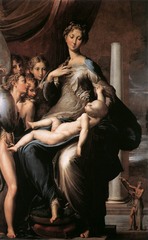
Madonna of the Long Neck
1535
*: curious length of the Madonna’s swan-like neck.
*: It shows the Madonna, seated on a high pedestal and clothed in beautiful robes, holding the baby Jesus on her lap. To the left of the picture are four angels crowded around the Madonna, looking admiringly on Christ.
*: The subject of this piece is derived from medieval hymns which compared the Virgin’s neck to a great ivory tower or column. Therefore the exaggerated length of the Virgin’s limbs and those of her son and the presence of columns in the background of the painting, are symbolic of the painting’s religious value.
*: Unlike the calm and peaceful Madonnas that Raphael painted, Parmigianino’s painting gives more of a sense of abandon and movement. The Madonna’s posture is relaxed, open and perhaps just a little carefree.
Parmigianino studied and admired the grace and poise in Raphael’s art, but he has remodeled the figures from the old master’s work and turned them into almost unearthly creatures: their limbs, ivory marble skin, blithe attitude, all portray a different idea of ideal beauty.
* :The Madonna does not have normal human proportions; her neck, shoulders and fingers have all been elongated to make her appear more elegant and graceful. Her hair is also elaborately curled and decorated with pearls to frame her beautiful face and complexion. The robes she is wearing are luxurious and flowing.
Parmigianino has stretched and lengthened bodily parts in the painting in a strange and impulsive way. The Angel’s leg in the foreground is glossy and suggestive, whilst the prophet, holding up his scroll, looks emancipated and gaunt. The lavish, inviting image of the Madonna, combined with crowd of Angels in various states of undress has led some critics to believe that Parmigianino was trying to eroticize the scene.
An oversized Christ child is splayed across the Madonna’s lap. The way his arm is hanging freely down is also a pose suggestive of death, adding to the sense of ambiguity surrounding the painting.
*: Instead of giving a sense of equilibrium and balance to his arrangement, Parmigianino has chosen to pack all the angels claustrophobically to the left of the Madonna. Yet, the space to the right of her is open, except for the tall figure of St Jerome who has been so reduced in size he only just about reaches the Madonna’s knee.
The viewer’s eye is forced to restlessly move around the painting in order to take in the disproportions of the tiny St Jerome to the overbearingly large figure of the Madonna. Even the architecture surrounding the Madonna looks to be out of proportion, with the strange sized column which looks to have no base or supporting structures behind it.
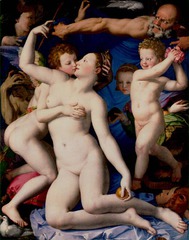
Allegory of Venus
1546
*: Bronzino’s portraits are immaculately realistic in detail with his subjects exuding blank, stoic expressions, yet with a sense of nobility and haughtiness.
*: His use of color is primarily what sets Bronzino’s style apart from Pontormo’s and earned him a permanent place among the great Italian Mannerists. He tended to exaggerate bright and bold colors in his portraits of the noble Medici family.
*: the elaborate style of Mannerism that was so fashionable in Italy at the time
*: a cool, detached realism, courtly elegance and vivid colour
*: Pontormo was a pioneering figure in Mannerist art, a style which was a clear departure from the graceful classicism of High Renaissance painting, and which was characterized by the use of intense colours and rather artificial compositions of figures in elaborate poses.
*: extreme stylization
*: this painting proclaims a refined erotic ideal that reduces passion to a genteel exchange of gestures between figures as polished and rigid as marble
*: The literary quality of the allegory reflects Bronzino’s skill as a poet
*: The complexity of the conceit matches the complexity of the composition; the high quality of the technique matches the cleverness of the content.
*: Technical virtuosity, complex imagery, inventive compositions perfectly accorded with their taste and exemplify the Mannerist style
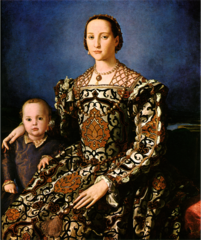
Portrait of Eleanora of Toledo and her son Giovanni de’ Medici
1550
*: The basic format of this work, Eleonora sitting on a balcony with a watery landscape to her left, is reminiscent of the Mona Lisa. Yet, her pale, oval face, harsh stare and rigid bodice counterbalance this. Her dress symbolizes the revival of the Florentine silk industry and like Ingres and Matisse, Bronzino depicts patterned textiles with elegance. It is said that Eleonora loved this particular dress and wore it often. It was also rumored that she was buried in it when she died in 1562 from malaria, but that claim has been refuted.
*: One of the hallmarks of Bronzino’s portraits is to depict his sitters with placid, uninvolved facial expressions that reflect the smug arrogance common amongst the noble class in Florence at this time. The faces of mother and son in this portrait, although slightly more expressive than some of Bronzino’s portraits, are void of any real emotion.
*: They are painted with meticulous detail and are extremely life-like, but they are like masks, revealing nothing about the individual’s thoughts or feelings. Bronzino also takes great care to paint the faces using light and shadow, giving them a three-dimensional appearance on the canvas.
*: a new type of court portrait
*: highly idealized painting of the wife whose features are perfected in the portrait
: ideal sense of beauty
*: The Dynastic message of Medici power is delivered by means of the formality of the portrait, with its frozen poses and aloof glances
*: complicated brocaded dress and jewelry that demonstrates her wealth and status
*: This image contains a complex set of allusions as flattering as the improvements to her looks.
: Bronzino’s painting describes the sitter as a member of an exalted social class, not as an individual personality. The kind of formal, distant, and allusive court portrait quickly became the ideal if court throughout europe
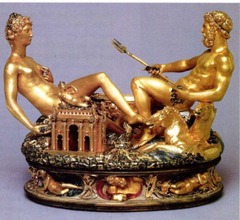
Saltcellar of Francis
1540-1543

Rape of the Sabine Women
1583
*: The artist’s use of exaggerated gestures, along with his ability to convey a sense of intense energy, characterize his style of Mannerism.
*: The dynamic figurative composition spirals upward in a twisting figura serpentinata, with no frontal view. This is one of the unique attributes of the statue – it offers multiple viewpoints, and its impact changes with the viewer’s position. Some art critics are uncomfortable with the tight verticality of the composition: our Editor is not one of them. In his opinion, this only adds to the physical drama of the event being illustrated.
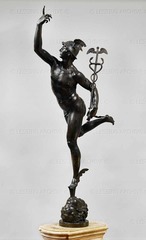
Mercury
1576
*:

Assumption of the Virgin
Duomo
Parma
1522-1530
*: illusionistic perspective
*: a new kind of visionary representation in which Heaven and earth are joined visually and spiritually through the magic of perspective and the artist’s skill.
*: gravity eliminated
*:
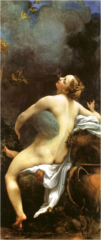
Jupiter and Io
c. 1532
*: beguiling, erotic nature
*: handling colour or at depicting the softness of flesh and the texture of hair.
*: In Jupiter and Io, he envelopes himself in a dark cloud in order to seduce the nymph Io – daughter of Inachus, king of Argos. Earlier, he had approached lo in his own guise and asked her to come into the woods with him, but when she fled he turned himself into a cloud and pursued her.
*: Correggio’s mastery of sfumato which allows him to create a seamless tonality in both Io’s body and the cloud which is about to engulf her. Note also the contrast between the chameleon-like immateriality of Jupiter, and the sensual substance of Io’s body, which anticipates Rubens’ female nudes as well as the euphoria of Bernini’s Ecstasy of Saint Teresa (1647-52).
*: The use of Leonardesque sfumato, combined with a Venetian sense of color and texture, produces a frank sensuality that exceeds even Titian’s Bacchanal. Correggio renders the vaporous form of the god with a remarkable degree of illusionism. The eroticism of the image reflects a taste shared by many courts of Europe
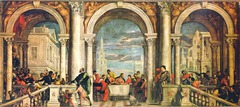
Christ in the House of Levi
1573
*: He is particularly renowned as one of the great colourists of the Mannerism school
*: derived from his development of Titian’s use of dramatic light and emotional intensity, Veronese achieved his by developing Titian’s mastery of colour – what was dismissively known as colorito by artists in Rome.
*: extraneous, irreligious detail.
*: symmetrical composition harks back to paintings by Leonardo and Raphael, while the festive mood of the scene reflects examples by Titian of the 1520s.
*: not so interested in conveying spiritual or psychological depth
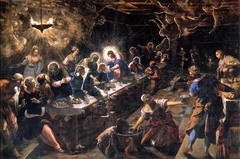
The Last Supper
S. Giorgio Maggiore
Venice
1592-1594
*: His intense illusionist style – very much part of the school of Venetian painting and very different to the greater naturalism of mainstream Renaissance art – emphasized the mystical side of religious experience and paved the way for the intensity and illusionism of Baroque painting, which later reflected the dogmas of the Roman Catholic Counter-Reformation.
*: a special atmosphere by using two light sources, darker colors and transparent, hovering angels. The angels add a supernatural
*: The lines of the table, the pattern on the floor and the wood in the ceiling create a linear perspective
*: denial of balance of clarity
*: the table is placed at a sharp angel to the picture plane in exaggerated perspective
*: everyday setting
*: The smoke from the blazing oil lamp miraculously turns into clouds of angels, blurring the distinction between the natural and the supernatural and turning the scene into a magnificently orchestrated vision.
*: miraculous in both real and symbolic terms




